Ethiopia is a country located in the Horn of Africa and is home to a diverse range of birds. Ethiopia’s birds are found in a variety of habitats, from the highlands of the Great Rift Valley to the lowlands of the Sudan.
With over 860 species of birds in Ethiopia, it is the most bird-rich country in the continent. Ethiopia’s birds come in all shapes and sizes, ranging from the majestic Lammergeier to the diminutive White-rumped Seedeaters.
Ethiopia’s birds are also a major tourist attraction, drawing in birdwatchers and photographers from all over the world. In this article, we will explore some of the most interesting and iconic birds of Ethiopia.
1. Blue-Winged Goose
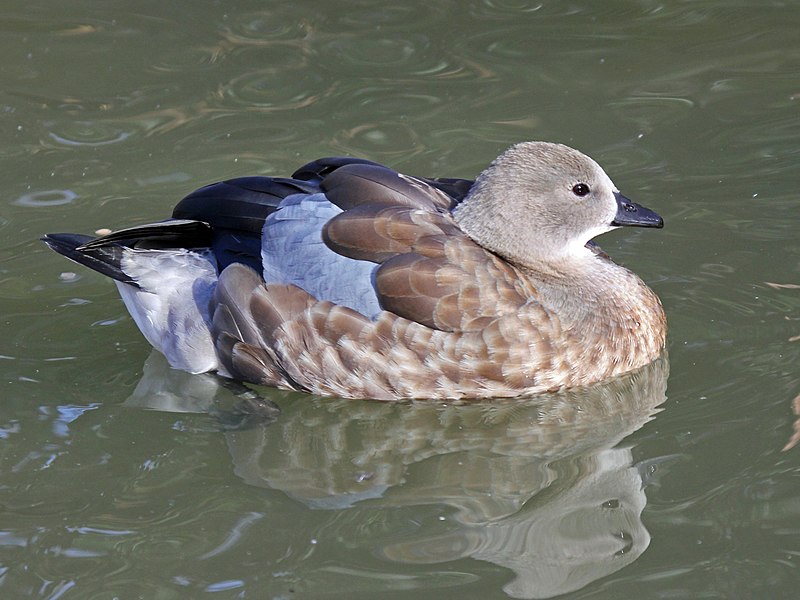
The Blue-winged Goose (Cyanochen cyanoptera) is a unique species of waterfowl native to Ethiopia. It is the only member in its genus, and there has been uncertainty over where it sits within the waterfowl family tree.
Morphologically, this bird closely resembles shelducks and South American sheldgeese – they share similar courtship displays too.
Genetic analyses using mitochondrial DNA have confirmed that this species is not related to other geese or ducks; instead, Blue-winged Geese likely belong to an ancient lineage of birds which diverged before most current waterbird families had evolved.
The striking plumage pattern makes them easy to spot out on their marshy habitats across Ethiopia’s highlands – be sure keep your eyes peeled for these beautiful creatures.Scientific classification:
| Kingdom | Animalia |
| Phylum | Chordata |
| Class | Aves |
| Order | Anseriformes |
| Family | Anatidae |
| Genus | Cyanochen Bonaparte, 1856 |
| Species | C. cyanoptera |
Also Featured In: Endemic Ethiopian Birds You don’t Know,
2. Ethiopian Siskin
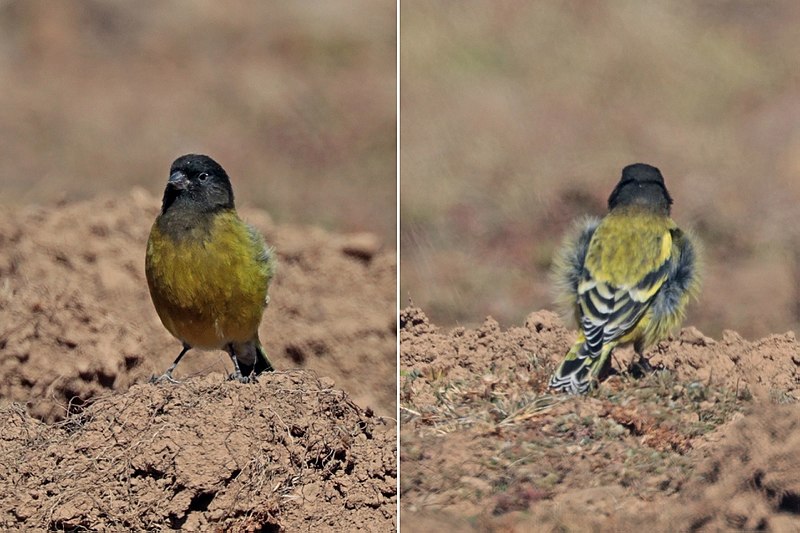
The Ethiopian siskin, also known as Abyssinian siskin, is a species of finch bird that can only be found in Ethiopia. It inhabits the high altitude Afromontane grassland areas at altitudes above 2,000 metres (6,600 ft).
This small and beautiful bird has mainly brownish grey plumage with dark green wings and tail feathers.
Its crown and upperparts are black while its throat is yellow with white markings around it. The male has a bright red bill compared to the female’s duller one.
Antonio Arnaiz-Villena et al have been successful in obtaining this captivating species for study purposes – highlighting how special they truly are.Scientific classification:
| Kingdom | Animalia |
| Phylum | Chordata |
| Class | Aves |
| Order | Passeriformes |
| Family | Fringillidae |
| Subfamily | Carduelinae |
| Genus | Serinus |
| Species | S. nigriceps |
3. Spot-Breasted Lapwing
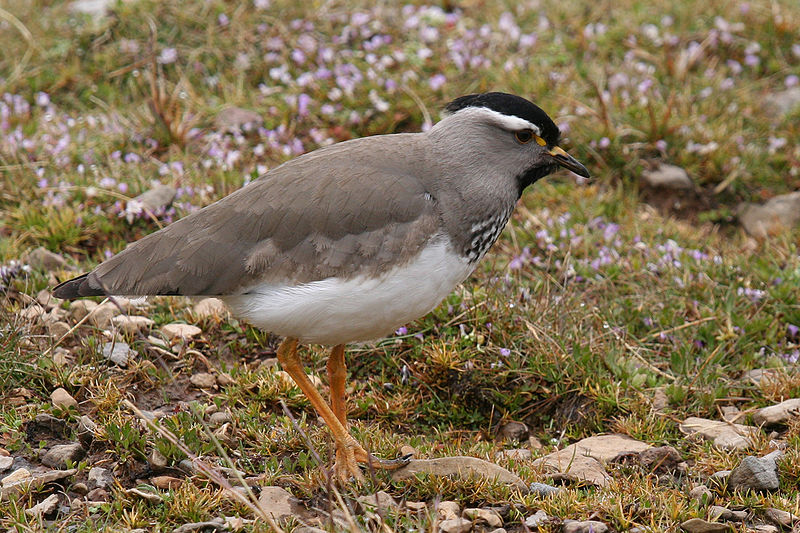
The Spot-breasted Lapwing is a species of bird that is endemic to the Ethiopian highlands. It has chunky body with a black cap, white eyebrow and black throat.
The most distinctive feature are its coarse spots across the breast. This interesting lapwing inhabits both wet and dry montane habitats such as grassland, moorland and marsh.
They feed mainly on insects found in these areas by foraging on foot or hovering over waterbodies like lakes or rivers to catch aquatic prey.
Although it faces no major threats at present, their populations may be declining due to destruction of its habitat due to human activities such as deforestation which may affect them negatively in future if conservation measures aren’t taken soon enough .Scientific classification:
| Kingdom | Animalia |
| Phylum | Chordata |
| Class | Aves |
| Order | Charadriiformes |
| Family | Charadriidae |
| Genus | Vanellus |
| Species | V. melanocephalus |
4. Wattled Ibis
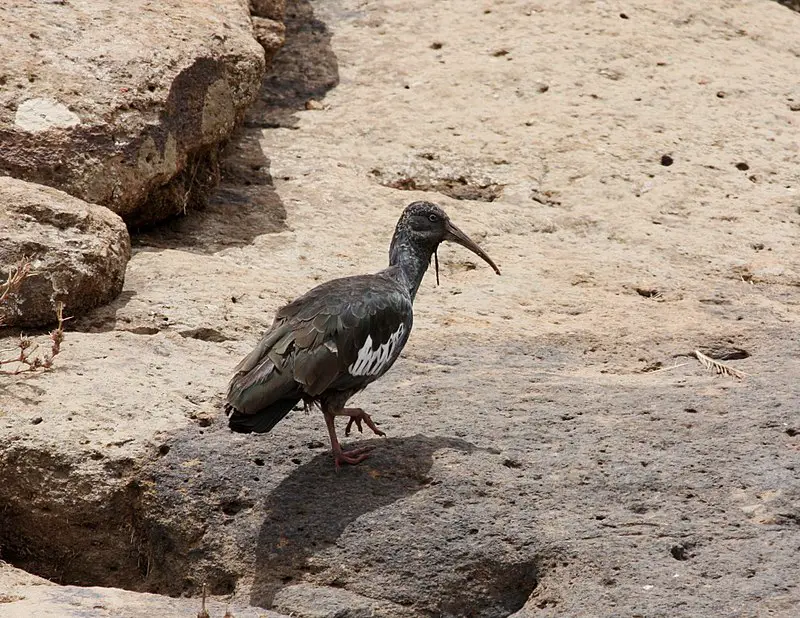
The Wattled Ibis is a beautiful dark brown bird, native to the Ethiopian highlands and Eritrea. Distinguished by its crested head, short bill and long tail it also has an extensive white patch on its wings.
It feeds mainly on small invertebrates but can also take larger prey such as frogs and lizards when available in their habitat of grassland areas with scrub or semi-arid wooded habitats.
During breeding season they form monogamous pairs which build nests near water sources so that both parents can provide food for the chicks more easily.
The male will perform courtship displays to attract a mate before building the nest together from sticks and twigs lined with soft grasses and feathers from other species of birds.
This remarkable species helps maintain healthy ecosystems through controlling insect populations making them important contributors to biodiversity conservation efforts across Africa.Scientific classification:
| Kingdom | Animalia |
| Phylum | Chordata |
| Class | Aves |
| Order | Pelecaniformes |
| Family | Threskiornithidae |
| Genus | Bostrychia |
| Species | B. carunculata |
5. Abyssinian Longclaw
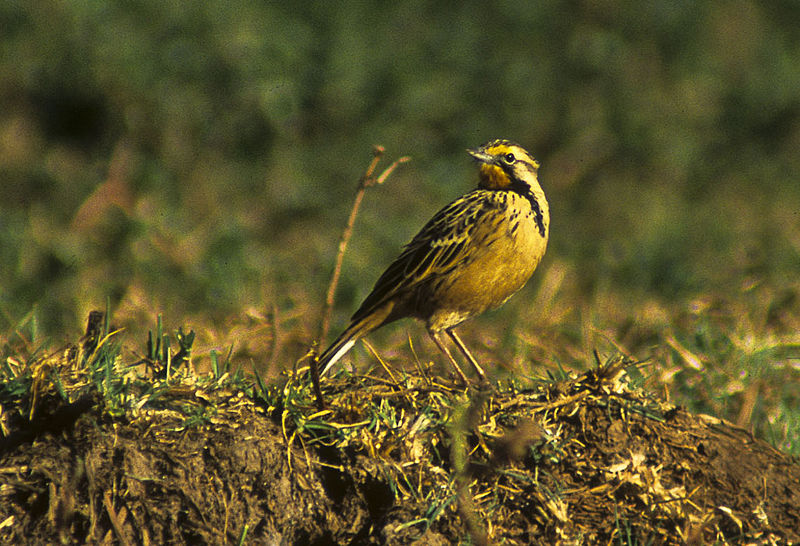
The Abyssinian longclaw is a species of bird belonging to the family Motacillidae, natively found in Ethiopia. It inhabits subtropical or tropical high-altitude grasslands and arable lands of the Ethiopian Highlands.
This vibrant bird has yellowish-brown head with black stripes on its crown and white throat which makes it distinguishable from other birds in its family.
In terms of behavior, this small passerine follows similar patterns as that of Yellow-throated Longclaw also known as Macronyx croceus which belongs to same group but resides elsewhere in Africa.
As per IUCN Red List data, these birds are labeled under Least Concern category owing their widespread population across natural range area despite being prone to threats like habitat destruction due to urbanization & agricultural activities.Scientific classification:
| Kingdom | Animalia |
| Phylum | Chordata |
| Class | Aves |
| Order | Passeriformes |
| Family | Motacillidae |
| Genus | Macronyx |
| Species | M. flavicollis |
6. Ruspoli’s Turaco
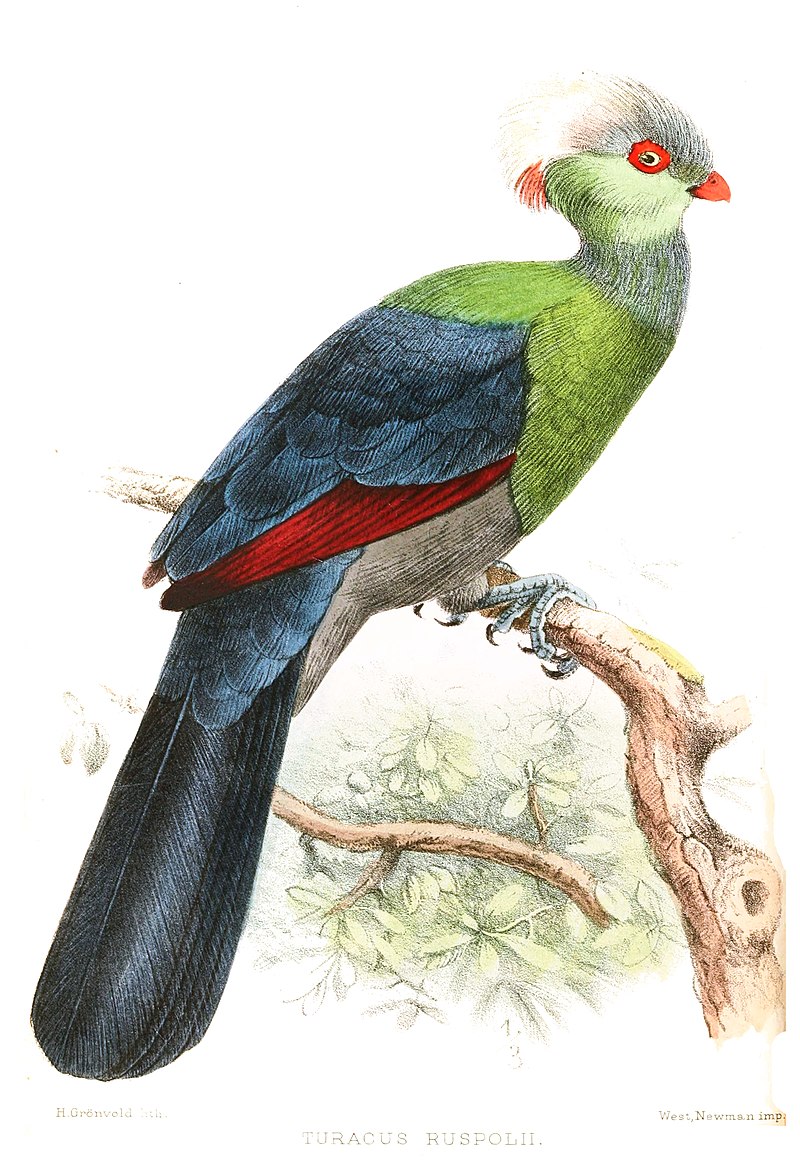
Ruspoli’s Turaco is a species of bird found in southern Ethiopia, and is the only known member of its genus. Its natural habitat consists of subtropical or tropical dry forests, though it has seen rapid population decrease due to deforestation activities.
The species was discovered by Eugenio Ruspoli in 1892/93 but his sudden death meant that little else could be recorded about it until recently when conservationists began to research its ecology and habits more closely.
It features an impressive plumage with bright blue-green coloration on both wings as well as two white stripes running down each side from neck to tail feathers; adding further beauty are vibrant yellow eyes which contrast nicely against their black eye patches and facial markings.
Despite being classified as near threatened, Ruspoli’s turacos remain popular amongst birdwatchers for their unique colors and patterns along with their gentle nature – making them highly sought after despite still facing threats from human activity destroying their habitats.Scientific classification:
| Kingdom | Animalia |
| Phylum | Chordata |
| Class | Aves |
| Order | Musophagiformes |
| Family | Musophagidae |
| Genus | Menelikornis |
| Species | M. ruspolii |
7. Thick-Billed Raven
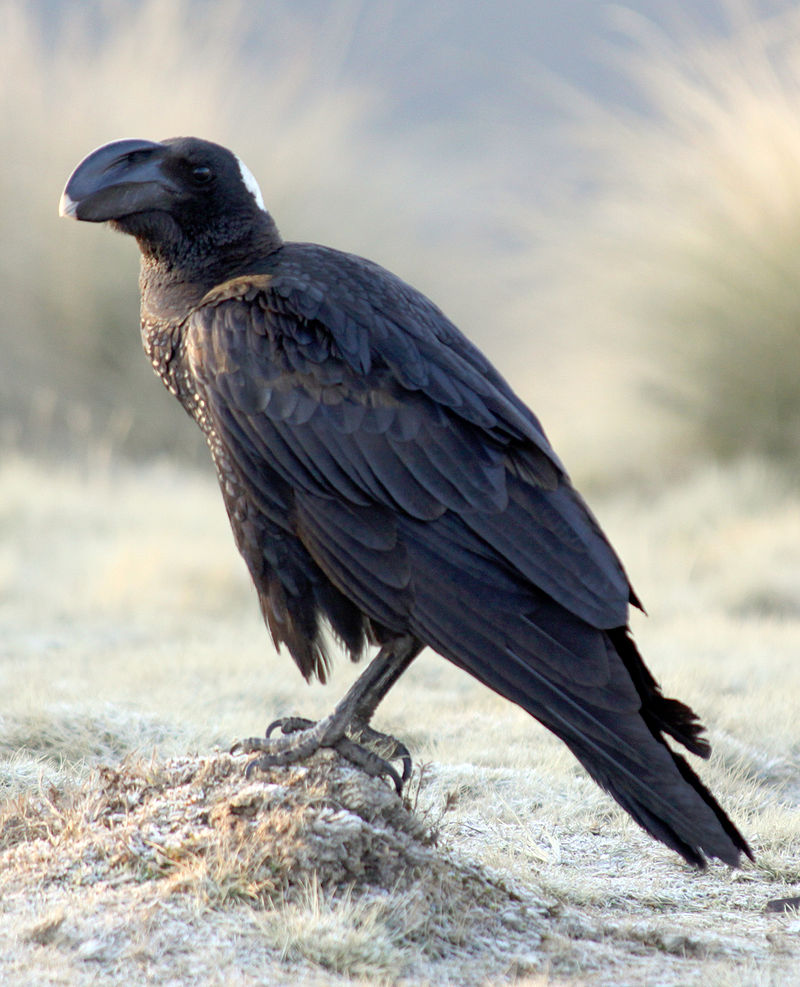
The Thick-billed Raven is a large and impressive member of the Corvid family. It has an average length of 64 cm, ranging from 60 to 70 cm with males weighing in at 1.5 kg and females at 1.15 kg.
This makes it one of the largest passerines out there. The body is mainly black with some white spotting on its chest and neck area.
However, this varies according to location as different subspecies can exhibit quite distinct features or even coloration changes altogether.
Its wingspan also ranges greatly depending on size but usually measures around 85 – 100cm across when fully extended.
All in all, this bird certainly stands out amongst other birds due to its impressive size combined with stunning plumage which often leaves onlookers breathless.Scientific classification:
| Kingdom | Animalia |
| Phylum | Chordata |
| Class | Aves |
| Order | Passeriformes |
| Family | Corvidae |
| Genus | Corvus |
| Species | C. crassirostris |
8. Black-Winged Lovebird
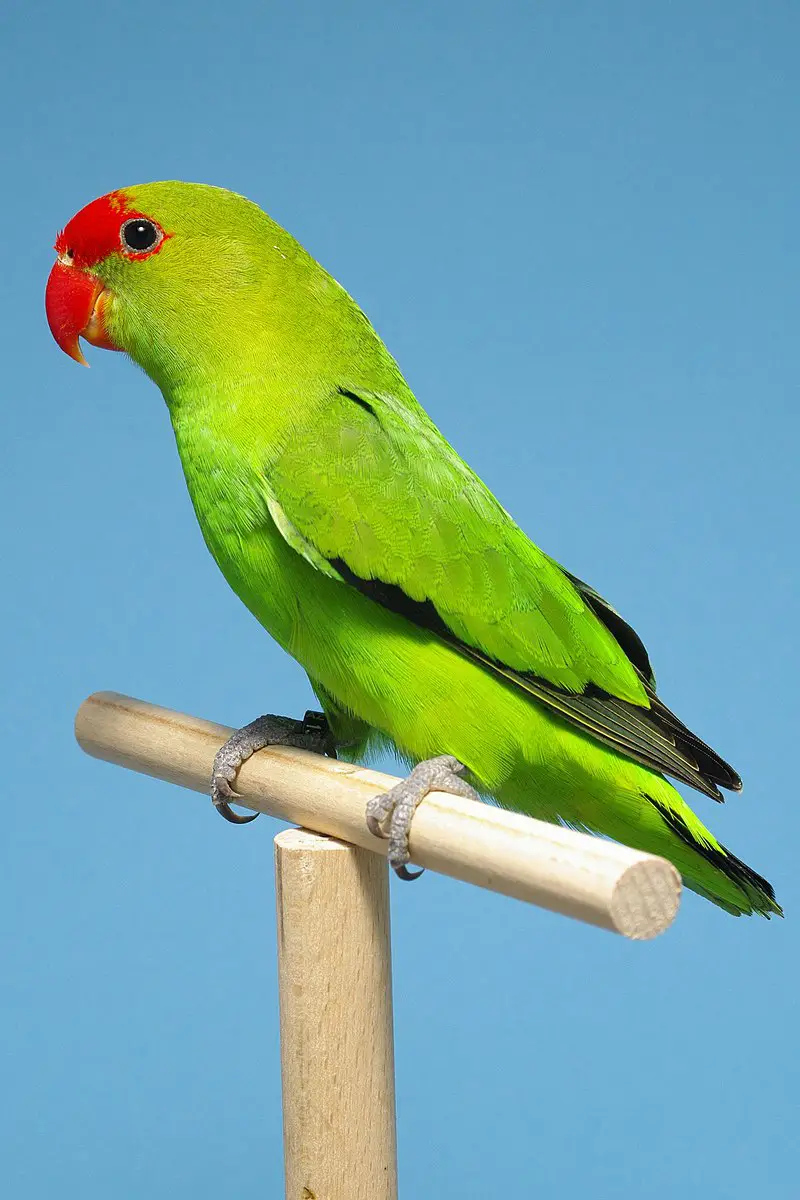
The Black-winged lovebird is a stunningly beautiful parrot from Ethiopia and Eritrea. It stands out in the Lovebird genus for its size, measuring up to 6.5 inches long and being the largest of the group.
Male birds can be identified by their red forehead while females have an all green head. These birds are not very common outside of their native range but they make great pets due to their friendly personalities and intelligence level as well as beauty.
They require lots of attention and interaction with humans or other birds so if you’re considering one, make sure you’re prepared to provide them with plenty of care.Scientific classification:
| Kingdom | Animalia |
| Phylum | Chordata |
| Class | Aves |
| Order | Psittaciformes |
| Family | Psittaculidae |
| Genus | Agapornis |
| Species | A. taranta |
9. White-Tailed Swallow
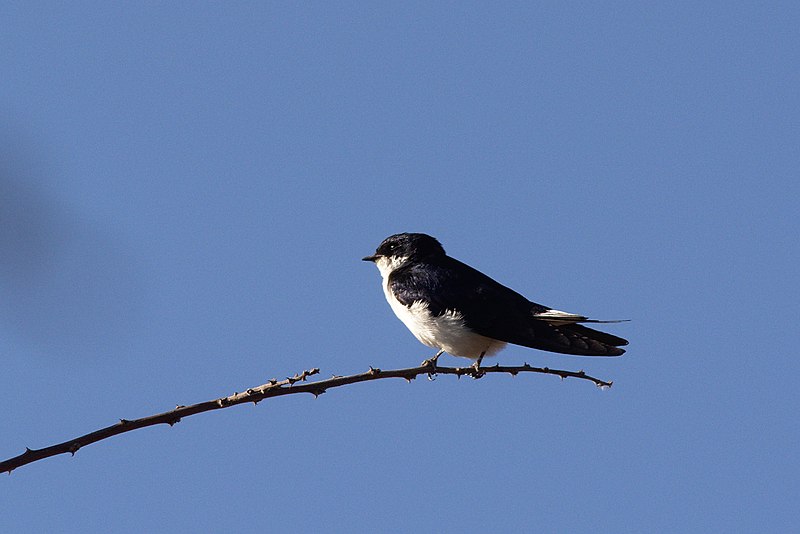
The White-tailed Swallow is a small bird belonging to the Hirundinidae family, native to Oromia in Ethiopia. It was named after ornithologist Constatine Walter Benson who first identified it.
The species has been classified as vulnerable by IUCN due to its decreasing population size and range loss caused mainly by human activities such as deforestation and agriculture expansion.
To protect this beautiful creature, conservation measures must be implemented in order for it not only survive but also thrive once again in its natural habitat.Scientific classification:
| Kingdom | Animalia |
| Phylum | Chordata |
| Class | Aves |
| Order | Passeriformes |
| Family | Hirundinidae |
| Genus | Hirundo |
| Species | H. megaensis |
10. White-Collared Pigeon
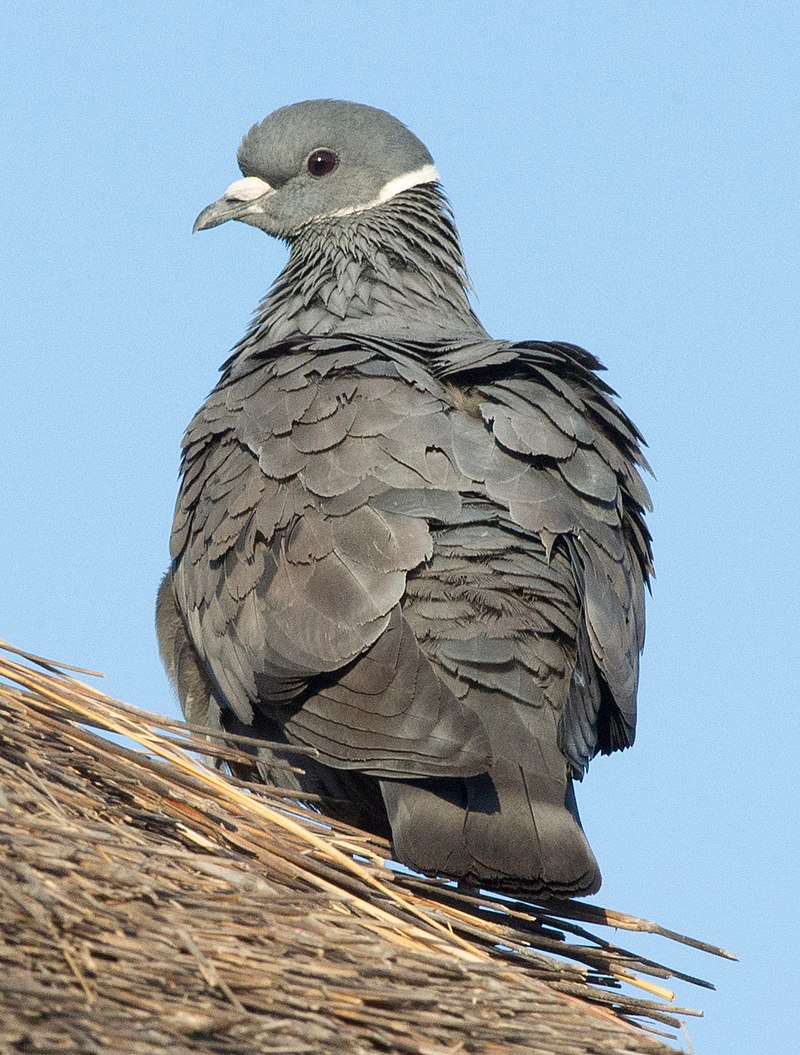
The White-collared Pigeon is a species of bird in the Columbidae family, endemic to Eritrea and Ethiopia. It inhabits rocky cliffs, gorges and city centres alike, standing at an impressive 32 cm tall.
This monotypic species has no recognised subspecies. The pigeon’s plumage is mainly grey with black wings and tail.
Its distinguishing feature however, are its white collars on either side of its neck which it gets its name from.
They feed mainly off grass seed but have been found consuming insects as well when food sources become scarce in their natural habitats during dry spells or drought seasons.
They build nests high up on cliff walls near water sources where they can raise their young safely away from predators like hawks or falcons that may prey upon them otherwiseScientific classification:
| Kingdom | Animalia |
| Phylum | Chordata |
| Class | Aves |
| Order | Columbiformes |
| Family | Columbidae |
| Genus | Columba |
| Species | C. albitorques |
11. White-Billed Starling
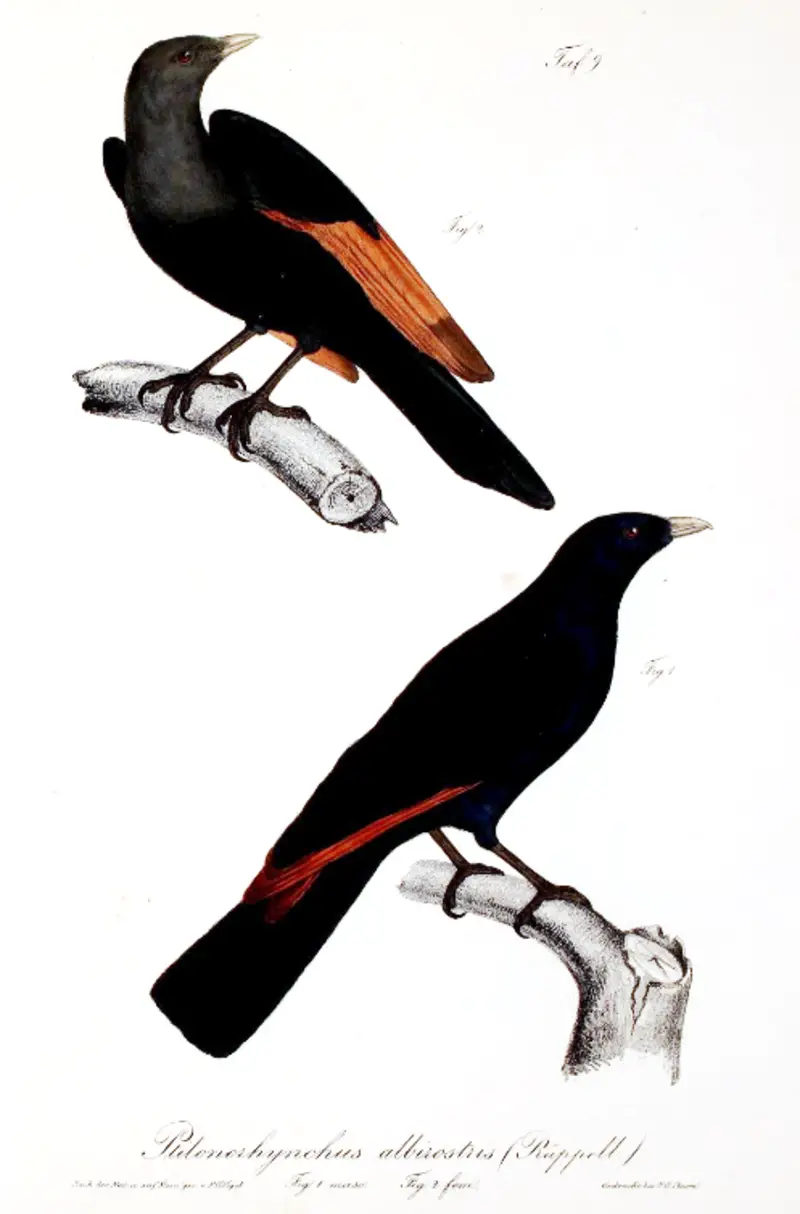
The White-billed Starling is an exotic bird species found mainly in the regions of Eritrea and Ethiopia. It has a unique white bill, which makes it quite distinctive from other starlings.
This beautiful bird prefers to live on steep cliffs and can often be seen perched high up in trees or soaring through the sky.
Its diet consists mostly of insects, fruits and seeds as well as some smaller animals like lizards and rodents that they find while foraging around their habitat.
The white billed starling is an important part of its local ecosystem since it helps control insect populations by preying upon them, making sure there’s enough food available for other species too.
They are also known to form large flocks during migration season when they travel long distances together looking for better feeding grounds.
Despite being so rare these stunning birds still manage to captivate us with their charm every time we see them.Scientific classification:
| Kingdom | Animalia |
| Phylum | Chordata |
| Class | Aves |
| Order | Passeriformes |
| Family | Sturnidae |
| Genus | Onychognathus |
| Species | O. albirostris |
12. Yellow-Fronted Parrot
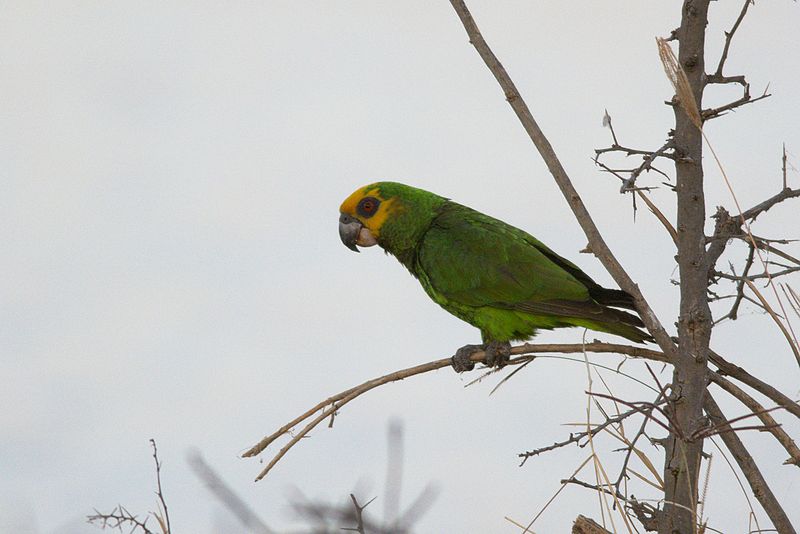
The Yellow-fronted Parrot is a beautiful bird endemic to the Ethiopian Highlands. Its plumage is mostly green with a yellow head, which gives it its name.
Not much has been studied about this species, but German naturalist Eduard Rüppell first described it in 1845 and gave it the scientific name of Poicephalus flavifrons derived from Latin words “flavus” meaning yellow and “frons” meaning forehead.
It’s also known as the Yellow-faced Parrot or by its local names such as Fishe Chikilu Tibs or Nech Wotch Guba among others. Undoubtedly, more research should be done on these birds to understand them better.Scientific classification:
| Kingdom | Animalia |
| Phylum | Chordata |
| Class | Aves |
| Order | Psittaciformes |
| Family | Psittacidae |
| Genus | Poicephalus |
| Species | P. flavifrons |
13. Abyssinian Woodpecker
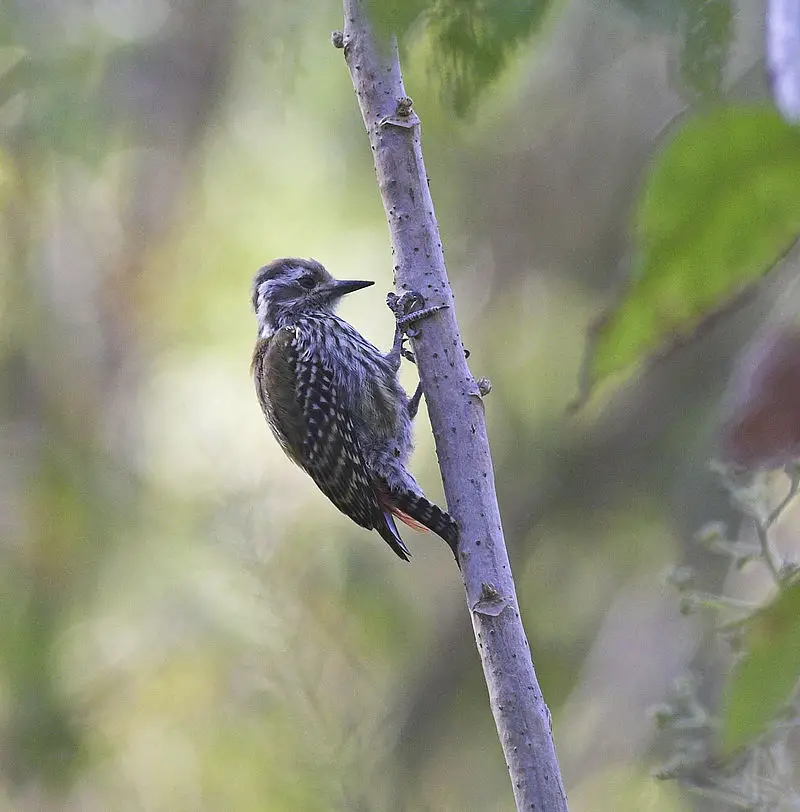
The Abyssinian woodpecker is a small bird native to Eritrea and Ethiopia in Africa. With its distinctive golden-backed feathers, it stands out among other species of birds within the Picidae family.
It has an affinity for acacia trees – often using them as perches while searching for insects under bark or digging into dead wood with their powerful beaks.
The Abyssinian also feeds on nectar from flowers and fruits found near these acacias.
As part of its adaptation to living in arid environments, this little bird can survive long periods without water due to its metabolic rate being lower than most other avian species.
Despite having such unique traits, the population size of this woodland resident continues to decline due largely to habitat destruction caused by humans activities like deforestation and charcoal burningScientific classification:
| Kingdom | Animalia |
| Phylum | Chordata |
| Class | Aves |
| Order | Piciformes |
| Family | Picidae |
| Genus | Dendropicos |
| Species | D. abyssinicus |
14. Banded Barbet
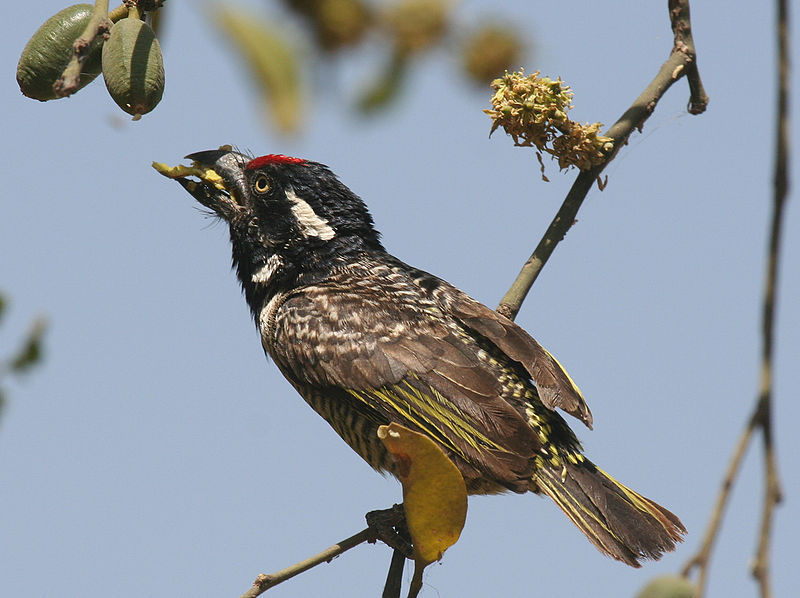
The Banded barbet is a species of bird found in Eritrea and Ethiopia, usually living between 300-2400 metres.
It has not been thoroughly studied yet so its exact population numbers are unknown – some areas have it as uncommon while other count them as locally common.
This small colourful bird sports a distinct black band across its chest which gives it its name; the rest of the body varies from yellow to green with red highlights around their eyes and beak.
They feed on fruit, insects and flower buds making sure they keep their environment healthy by helping spread seeds.
Despite being relatively unknown to most people, these birds provide an important ecological role in preserving plant life throughout Ethiopia’s landscape.Scientific classification:
| Kingdom | Animalia |
| Phylum | Chordata |
| Class | Aves |
| Order | Piciformes |
| Family | Lybiidae |
| Genus | Lybius |
| Species | L. undatus |
15. White-Winged Cliff Chat
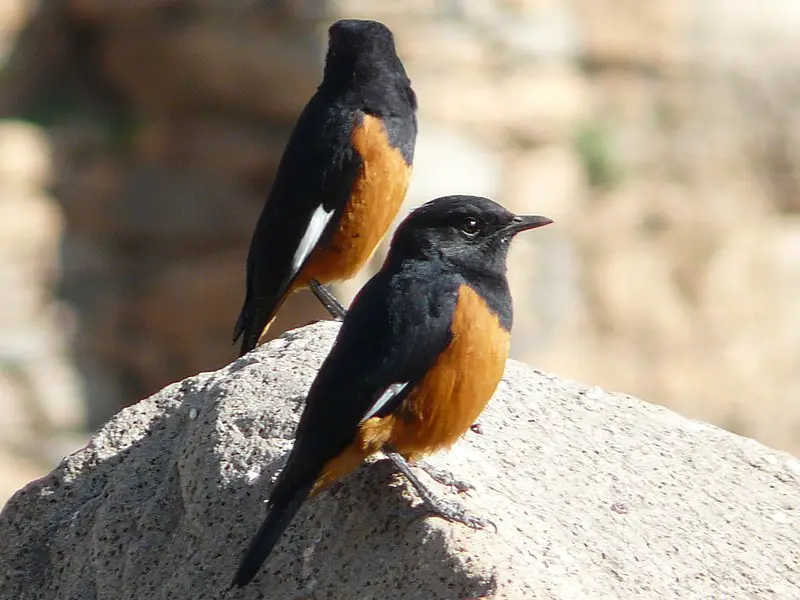
The White-winged Cliff Chat is a species of Old World flycatcher that resides primarily in the Ethiopian Highlands. It has an unmistakable plumage, with its wings and tail feathers white on one side and gray or black on the other.
Its habitat consists of rocky wooded gorges, among boulders, as well as road cuttings. This bird is known for being quite vocal – it produces various types of loud whistles to communicate with others around them during mating season or when defending their territory from intruders.
Despite this impressive trait however, they are still relatively unknown due to their low population numbers which make them vulnerable to extinction if conservation efforts aren’t taken soon enough.Scientific classification:
| Kingdom | Animalia |
| Phylum | Chordata |
| Class | Aves |
| Order | Passeriformes |
| Family | Muscicapidae |
| Genus | Monticola |
| Species | M. semirufus |
16. Ethiopian Oriole
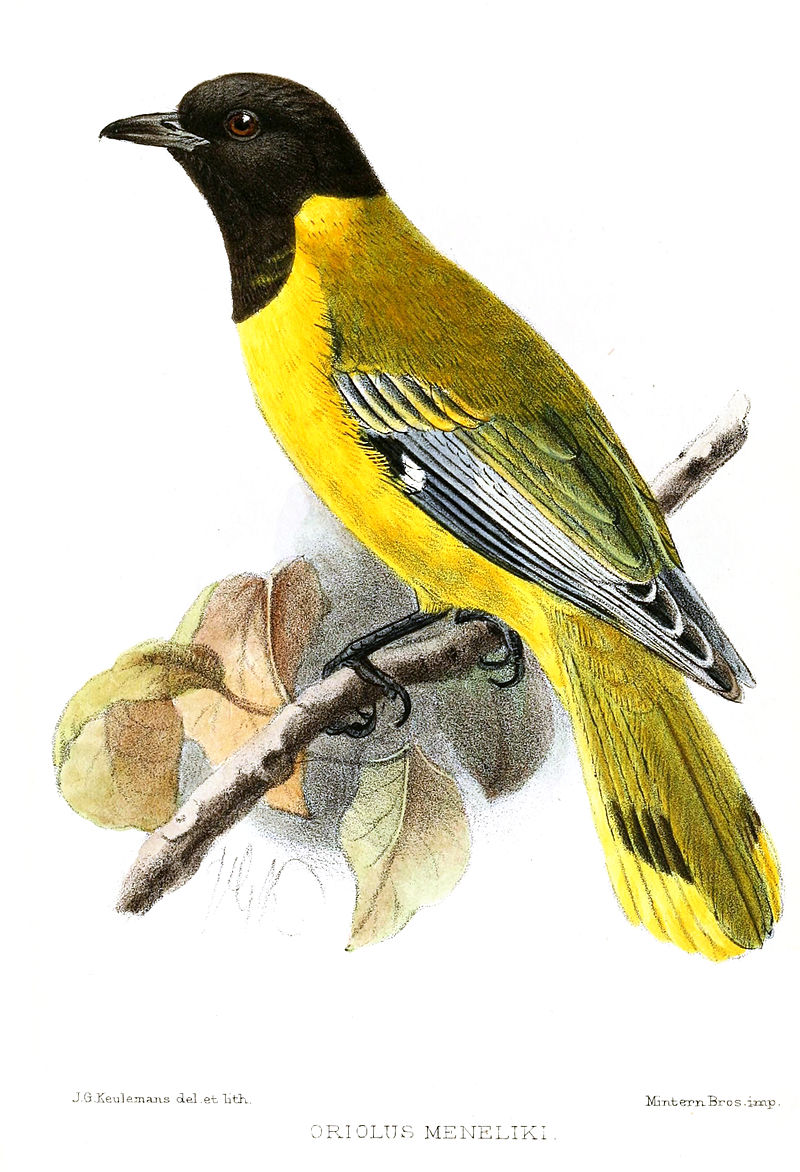
The Ethiopian Oriole is a species of bird belonging to the family Oriolidae. It inhabits subtropical and tropical dry forests of north-eastern Africa, where it’s known by alternate names such as Abyssinian Black-Headed Oriole, Abyssinian oriole or dark-headed oriole.
It has a black head with yellow eyes, white underparts and wings that are entirely black except for two bold yellow wing bars on each side.
The back is greenish olive in colour while its tail feathers have bright yellow tips. Its bill is pinkish grey in coloration with an orange tip at the end; females have slightly duller colors than males but otherwise look identical.
Feeds mainly on insects but also takes fruits from trees like mulberries and figs when available during different seasons throughout its range..Scientific classification:
| Kingdom | Animalia |
| Phylum | Chordata |
| Class | Aves |
| Order | Passeriformes |
| Family | Oriolidae |
| Genus | Oriolus |
| Species | O. monacha |
17. Harwood’s Spurfowl
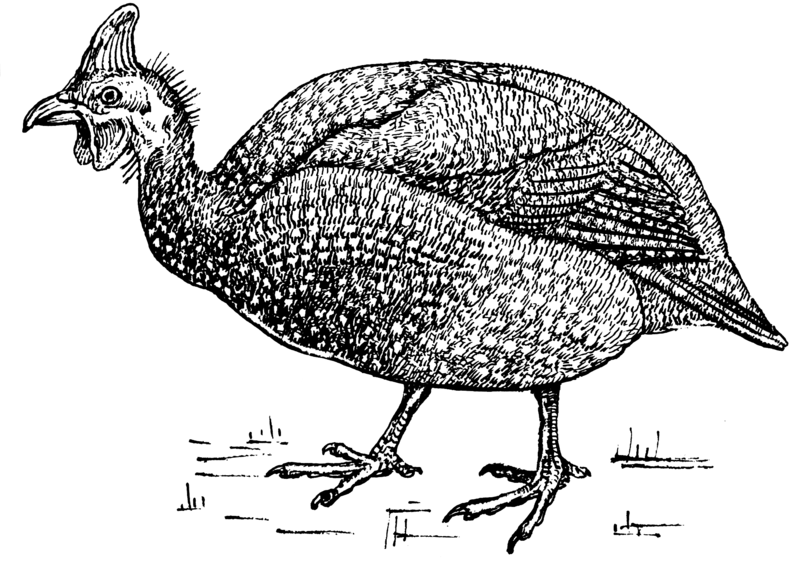
Harwood’s spurfowl is a species of bird native to the Ethiopian highlands. It has an unmistakable grey-brown plumage with red bill, tail and bare skin around its eyes.
Both males and females look similar in coloration though females tend to be slightly paler with a larger buff belly.
This species can mainly be found on either side of the Blue Nile valley where it inhabits wooded areas along riverbanks or at forest edges.
Its diet consists mostly of insects but they also feed on seeds and other fruits that are available seasonally in their habitat range.
Harwood’s spurfowl typically nests close to water sources such as streams or rivers which provides them protection from predators while also providing access to food resources near these waterways as well.Scientific classification:
| Kingdom | Animalia |
| Phylum | Chordata |
| Class | Aves |
| Order | Galliformes |
| Family | Phasianidae |
| Genus | Pternistis |
| Species | P. harwoodi |
18. Abyssinian Slaty Flycatcher
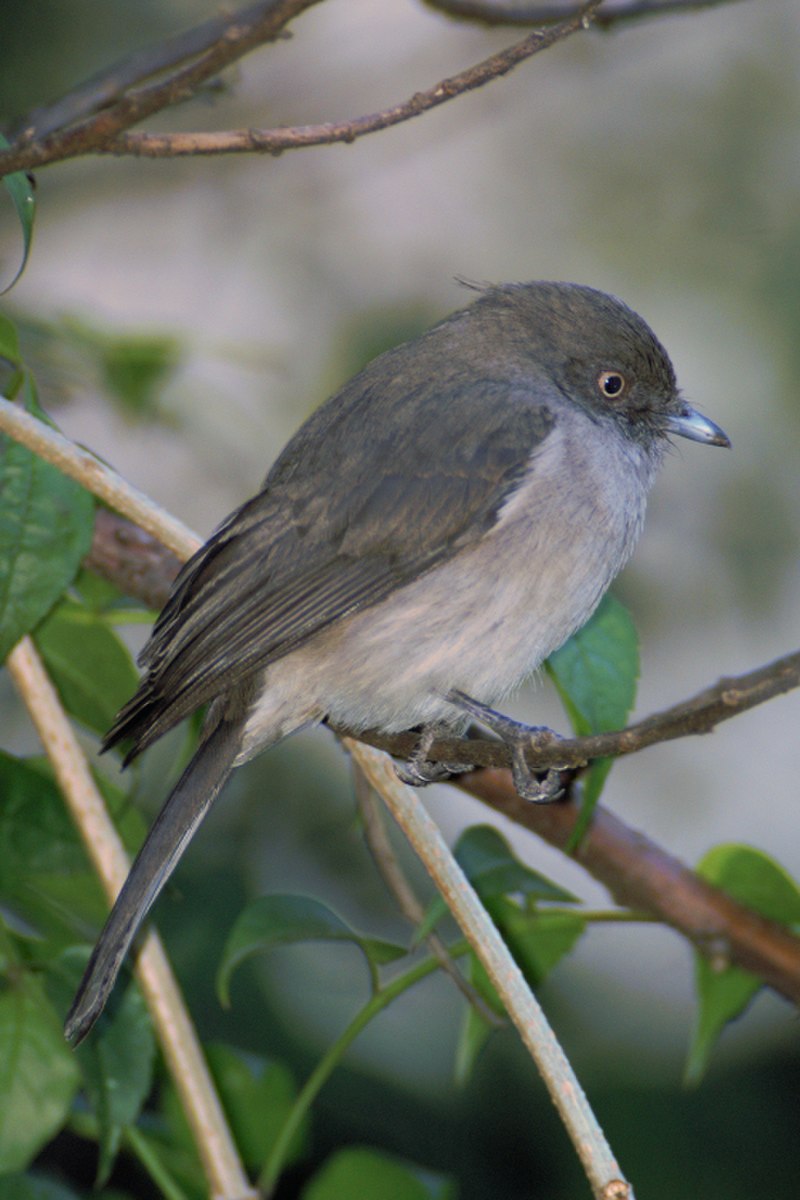
The Abyssinian Slaty Flycatcher is a small bird native to Eritrea and Ethiopia in Africa. It belongs to the family Muscicapidae, commonly known as Old World flycatchers.
This species typically has dark grayish-black plumage with lighter patches on its wings and tail feathers. Its head is generally light brown, which gives it its “chocolate” description in some of its common names.
Although this species can be difficult to spot due to its dull coloring, they are often heard before seen thanks to their distinctive call that sounds like a repeated “tchee” or “tsiip” sound when alarmed or excited by potential prey items.
These birds feed mainly on insects such as flies, beetles and wasps so they tend stay close to trees where there’s an abundance of these food sources.
Despite being relatively little studied compared other birds throughout Africa, the Abyssinian Slaty Flycatcher remains fairly widespread across both Eritrea and Ethiopia making them one of the more successful avian residents within the region.Scientific classification:
| Kingdom | Animalia |
| Phylum | Chordata |
| Class | Aves |
| Order | Passeriformes |
| Family | Muscicapidae |
| Genus | Melaenornis |
| Species | M. chocolatinus |
19. Turaco
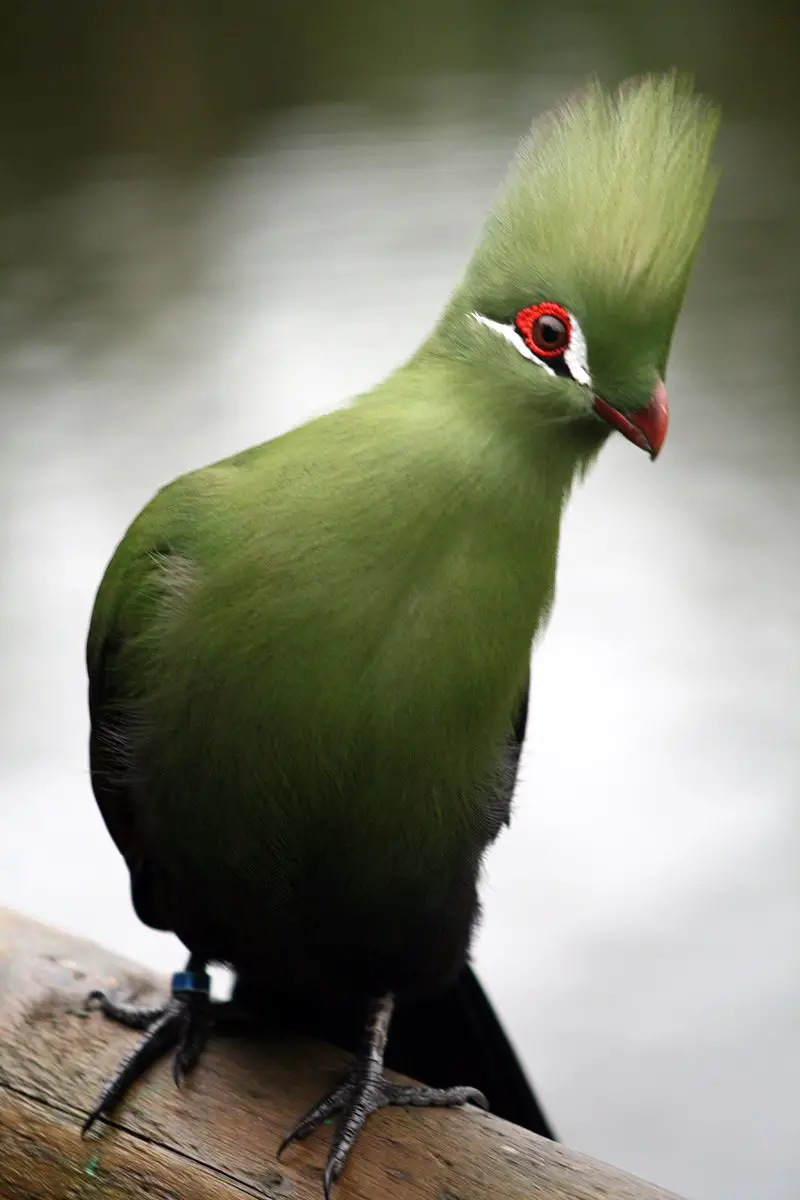
Turacos are a unique bird family that inhabit tropical and subtropical regions of Africa. They are also known as “banana-eaters” or “loeries” in southern Africa, due to their diet which consists mostly of fruit such as plantains.
These birds have an interesting semi-zygodactylous foot structure – the fourth toe can be switched back and forth while the second and third toes remain conjoined.
Turacos come in different sizes depending on species but they all generally boast bright colors like green, blue, purple or red feathers with vibrant yellow eyes.
In addition to being beautiful creatures, these birds make loud calls during mating season which makes them even more special.Scientific classification:
| Kingdom | Animalia |
| Phylum | Chordata |
| Class | Aves |
| Clade | Otidimorphae |
| Order | Musophagiformes Seebohm, 1890 |
| Family | Musophagidae Lesson, 1828 |
20. White-Backed Black Tit
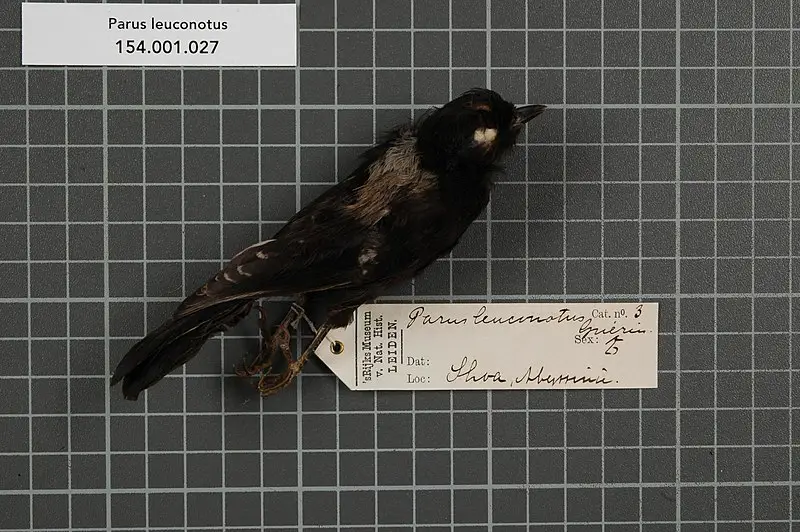
The White-backed Black Tit is a species of bird in the family Paridae and can be found in Eritrea and Ethiopia. Its natural habitat consists of boreal forests, providing plenty of food sources for it to survive on.
It was once classified as part of genus Parus but after further research into its molecular phylogenetic, it has since been moved to Melaniparus instead due to differences within its genetic makeup.
This black tit stands out from other birds with its unique white feathers covering most parts if its body – such as wings, tail and back – making this an eye catching sight when spotted amongst others.
Despite their size, they are surprisingly aggressive during breeding season towards any intruding competitors at the nest site which may threaten their young ones’ safety.Scientific classification:
| Kingdom | Animalia |
| Phylum | Chordata |
| Class | Aves |
| Order | Passeriformes |
| Family | Paridae |
| Genus | Melaniparus |
| Species | M. leuconotus |
21. Rüppell’s Black Chat
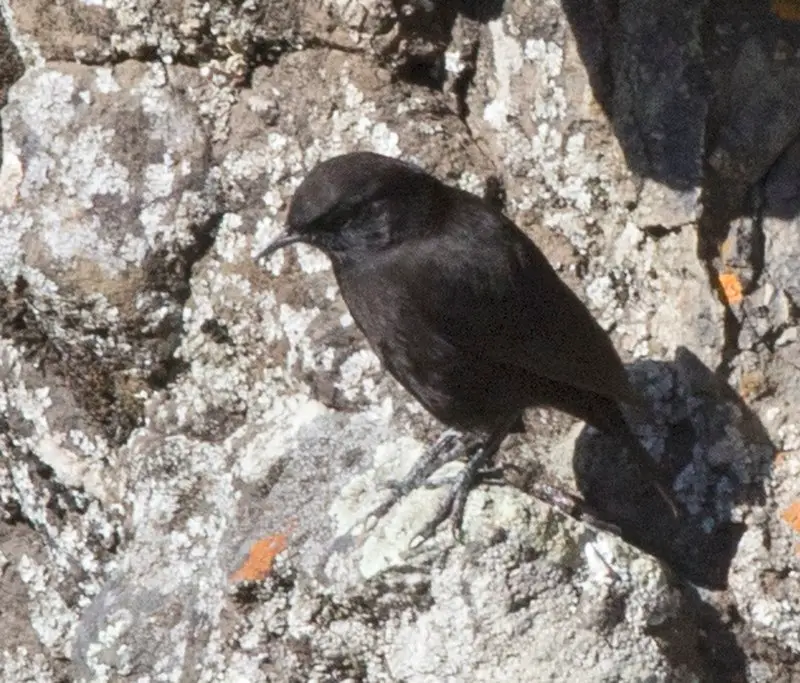
Rüppell’s black chat is a species of bird that belongs to the family Muscicapidae. It is endemic to Eritrea and Ethiopia where it lives in woodlands, scrubland, grassy areas and shrubland habitats.
The plumage of this chatbird is predominantly black with white spotting on its wings and tail feathers. Its underside has an orange-rufous colouration which distinguishes it from other birds in its habitat.
This small songbird typically feeds on insects such as beetles, ants, moths, bees and flies but will also eat seeds when available.
During the breeding season males are known for their loud calls made during territorial disputes or courtship displays with females; these calls can be heard up to 0.5 miles away.
Rüppell’s Black Chat may become threatened due to ongoing human activities such as deforestation however they remain common within suitable habitats across their range at present time making them one of several beautiful avian residents found there today.Scientific classification:
| Kingdom | Animalia |
| Phylum | Chordata |
| Class | Aves |
| Order | Passeriformes |
| Family | Muscicapidae |
| Genus | Myrmecocichla |
| Species | M. melaena |
22. Abyssinian Owl
The Abyssinian owl is a medium-sized true owl found in sub-Saharan Africa, from Senegal and Ethiopia to South Sudan. It has dark brown eyes, a black bill and grey eyebrows with prominent ear tufts that are slightly off center on its head.
Its plumage is mainly reddish brown or rufous marked white above the eye line, while below it’s barred white and buffy gray.
This species prefers dry savanna habitats where it can easily hunt for prey like insects, small birds and rodents during the night time hours when they’re most active.
In addition to being an efficient hunter of nocturnal creatures , this bird also exhibits interesting behavior such as flicking its wings up then down repeatedly before landing.
This serves both as a way to make itself appear larger to potential predators as well as attract mates since these movements signify strength & agility.Scientific classification:
| Kingdom | Animalia |
| Phylum | Chordata |
| Class | Aves |
| Order | Strigiformes |
| Family | Strigidae |
| Genus | Asio |
| Species | A. abyssinicus |
23. Yellow-Throated Seedeater
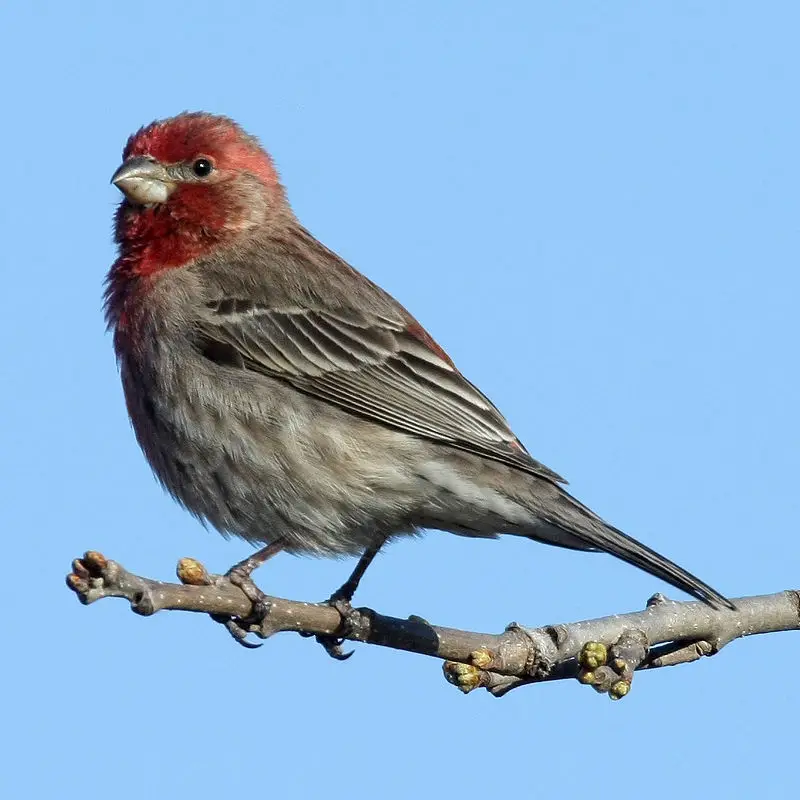
The Yellow-throated Seedeater is a beautiful species of finch found only in Ethiopia. It inhabits dry shrubland and grasslands, but its habitat is threatened by deforestation and loss of natural resources.
The bird has bright yellow feathers on its throat which contrast with the brown colouring on the rest of its body. Its song consists of jumbled chirps that are reminiscent to that of a canary’s call – ‘zeee-zsreee’.
This small bird prefers semi-desert areas where it feeds mainly on seeds from various plants as well as berries and insects when available.
Despite being vulnerable due to habitat destruction, conservation efforts like afforestation projects have been put into place to increase their numbers in nature reserves around Ethiopia.Scientific classification:
| Kingdom | Animalia |
| Phylum | Chordata |
| Class | Aves |
| Order | Passeriformes |
| Family | Fringillidae |
| Subfamily | Carduelinae |
| Genus | Crithagra |
| Species | C. flavigula |
24. White-Cheeked Turaco
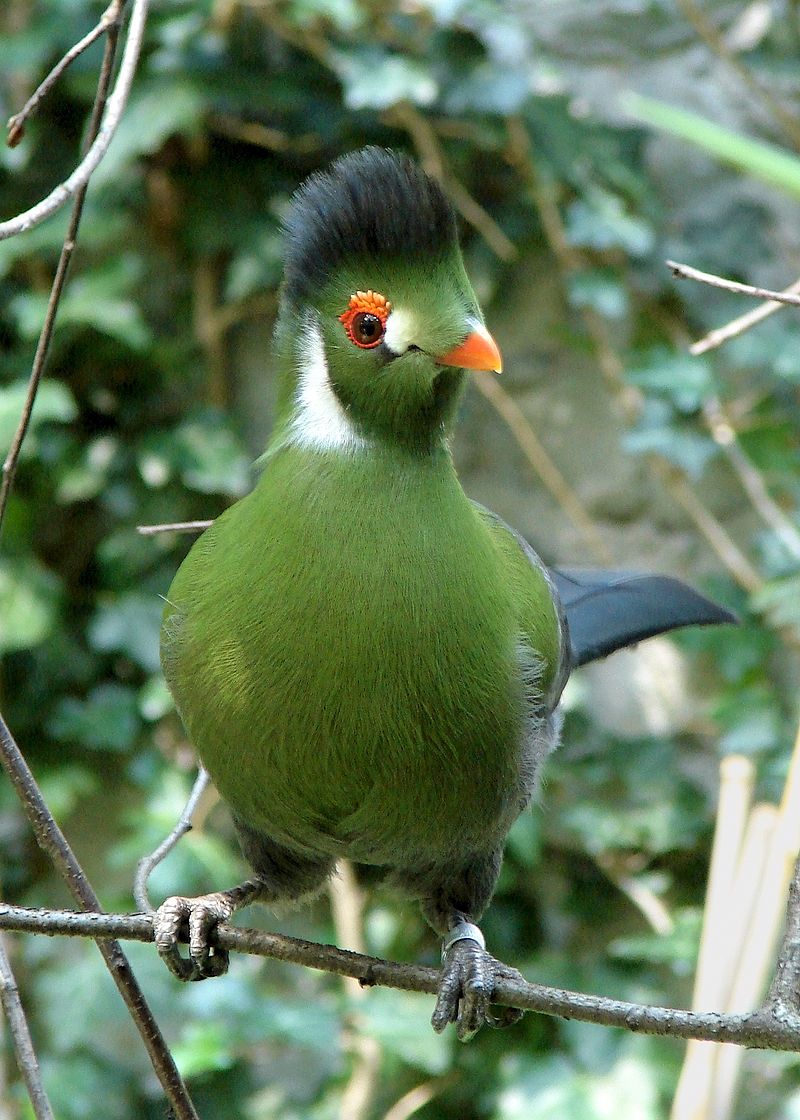
The White-cheeked Turaco is a large and vibrant bird that can be found in Eritrea, Ethiopia and South Sudan.
It has a long tail measuring around 19cm (7.5in) making it approximately 43 cm (17in) in length overall with an average weight of 200–315g (7.1–11.1oz).
They are distinguished by their bright red eyes, white cheeks and glossy green feathers often accompanied by black markings on the wings and back giving them a stunning appearance.
This species is also one of the most commonly kept turacos in captivity due to its wonderful colours which make it quite popular as an exotic pet or showbird.
Its diet mainly consists of fruits, insects, seeds and leaves providing plenty of nutrition for this magnificent creature.Scientific classification:
| Kingdom | Animalia |
| Phylum | Chordata |
| Class | Aves |
| Order | Musophagiformes |
| Family | Musophagidae |
| Genus | Menelikornis |
| Species | M. leucotis |
25. Salvadori’s Seedeater
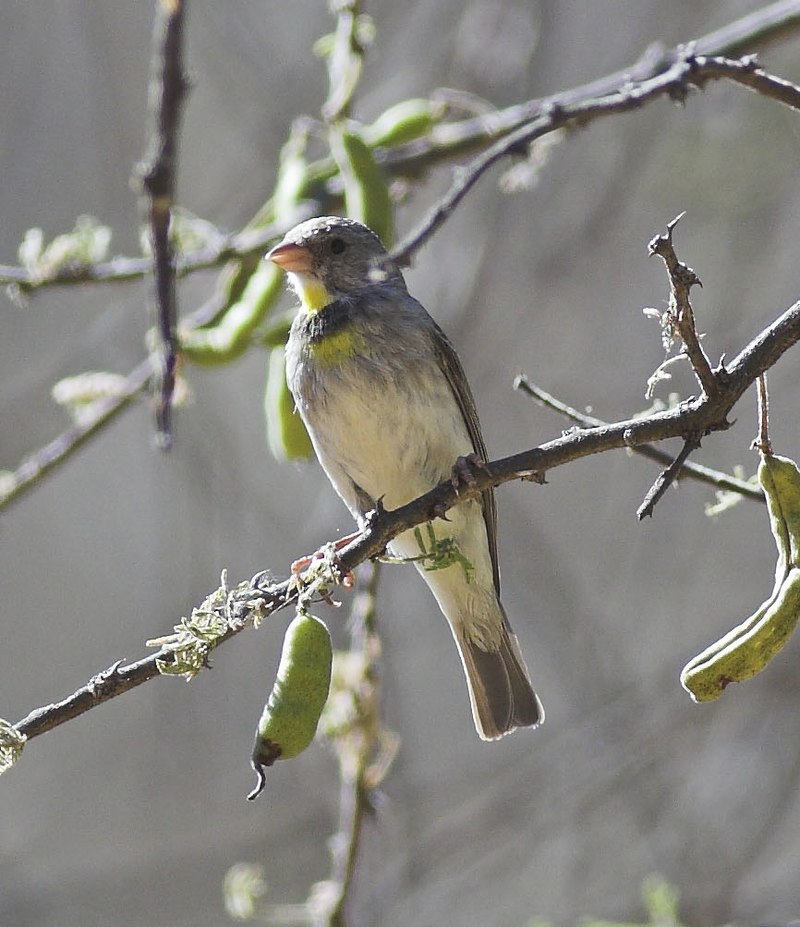
Salvadori’s seedeater is a species of finch native to Ethiopia. They inhabit dry forests and high-altitude shrublands, but are threatened by habitat loss due to human activity.
The bird has an olive green back with yellow underparts, white cheek patches and black eyebrows that cross the forehead.
Its bill and feet are orange in coloration while its eyes range from dark brown to red depending on age or sex.
These birds mainly feed on seeds found in their habitats such as grasses, weeds and other plants growing around them.
Their diet also consists of insects which they catch during flight or plucking it off vegetation near them.
Salvadori’s seedeaters have been classified as Near Threatened due to the rapid destruction of their natural habitats causing population declination across its range areas in EthiopiaScientific classification:
| Kingdom | Animalia |
| Phylum | Chordata |
| Class | Aves |
| Order | Passeriformes |
| Family | Fringillidae |
| Subfamily | Carduelinae |
| Genus | Crithagra |
| Species | C. xantholaema |
26. Chestnut-Naped Spurfowl
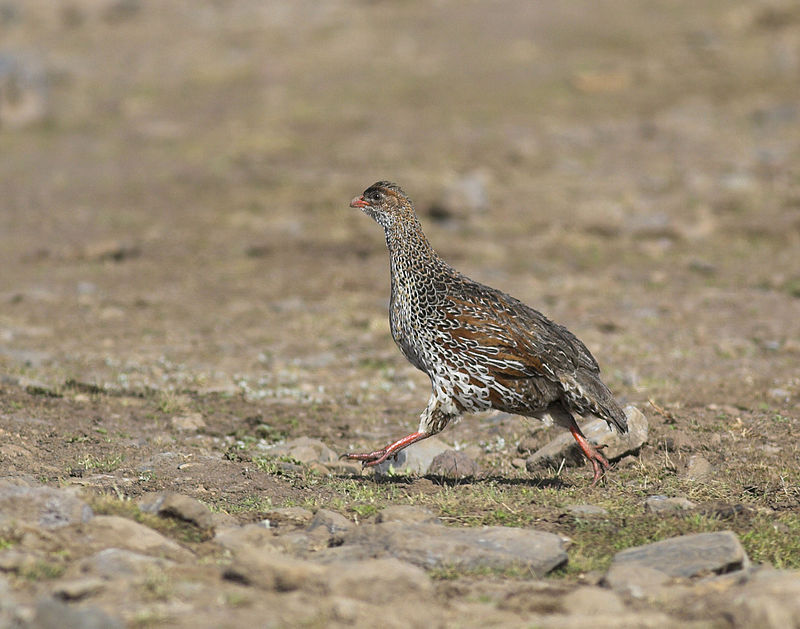
The Chestnut-naped Spurfowl is a large species of bird in the pheasant family. It is found mainly in Ethiopia and Somaliland, where it inhabits grasslands and wooded areas near water sources.
The chestnut-naped spurfowl can reach up to 33–37 cm (13–15 in) in length, with males weighing around 550–1,200 grams (19 – 42 oz). They are named after their distinctive chestnut colored nape feathers which contrast starkly with their black heads and gray wings.
Despite its wide range across Eastern Africa, there has been little research conducted on this species so far as not much information exists regarding population size or trends over time. However according to IUCN estimates the population appears stable for now but further study needs to be done for long term conservation effortsScientific classification:
| Kingdom | Animalia |
| Phylum | Chordata |
| Class | Aves |
| Order | Galliformes |
| Family | Phasianidae |
| Genus | Pternistis |
| Species | P. castaneicollis |
27. Abyssinian Ground Hornbill
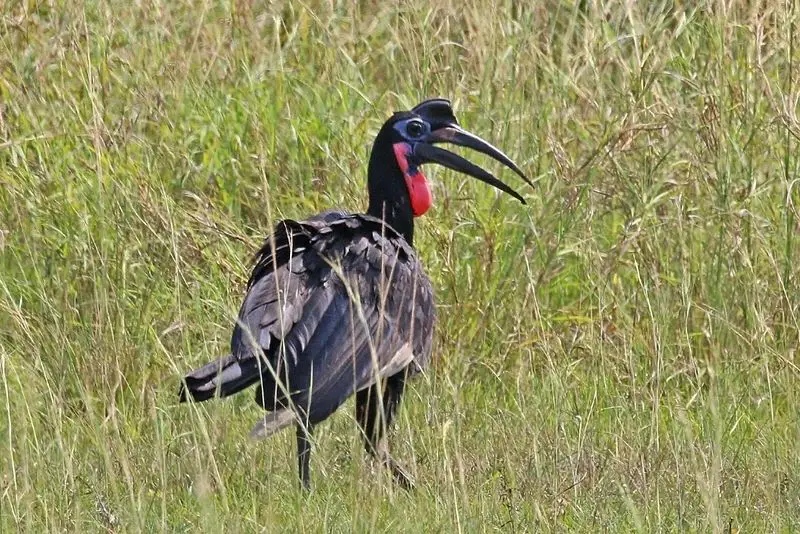
The Abyssinian ground hornbill is an African bird, found mainly north of the equator. It is one of two species of ground hornbills and second largest amongst all African Hornbills only surpassed by its slightly larger relative – southern ground hornbill.
This impressive bird was described by Georges-Louis Leclerc, Comte de Buffon in 1780’s and has a unique appearance with striking red facial skin surrounding bright yellow eyes.
The male birds are bigger than females and have different plumage colours (black/blue feathers) compared to their female companions who tend to be brownish grey.
They feed on insects, small mammals or reptiles which they hunt from the sky or find on land using their powerful feet for digging up prey items hidden underneath soil or sand.Scientific classification:
| Kingdom | Animalia |
| Phylum | Chordata |
| Class | Aves |
| Order | Bucerotiformes |
| Family | Bucorvidae |
| Genus | Bucorvus |
| Species | B. abyssinicus |
Also Featured In: Large Birds of Uganda,
28. Brown-Rumped Seedeater
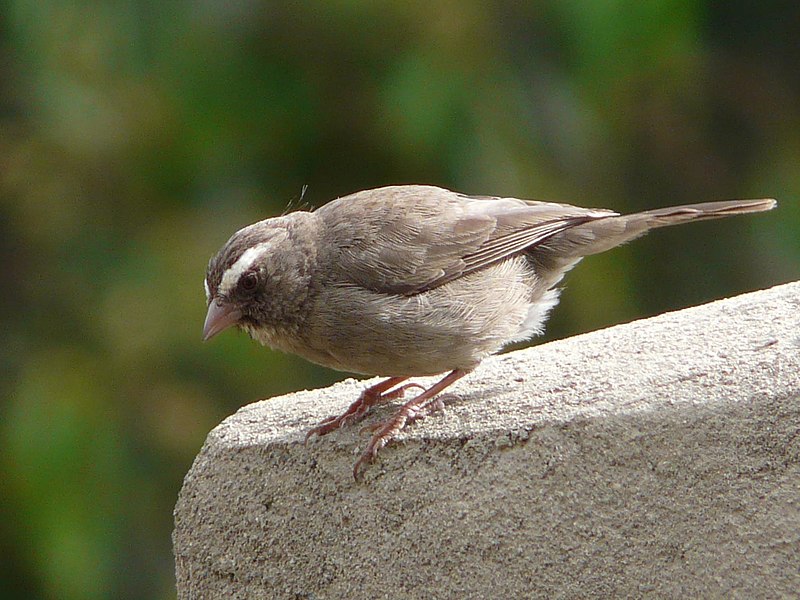
The Brown-rumped Seedeater is a species of finch found in the highlands of Ethiopia, Eritrea and Somalia. It’s quite widespread and can often be spotted in towns, villages gardens, plantations and upland heaths.
This bird has been reclassified from its former place within the genus Serinus to Crithagra due to DNA sequences that were analyzed for mitochondrial & nuclear information. The adult seeder eater has bright yellow underparts with brownish upper parts on their wings & crowns which are slightly darker than their back sides.
They also feature patches of grey on their wings & tails as well as white streaks across each feather giving them an elegant look when they fly or perch near trees or shrubs while searching for food such as seeds.Scientific classification:
| Kingdom | Animalia |
| Phylum | Chordata |
| Class | Aves |
| Order | Passeriformes |
| Family | Fringillidae |
| Subfamily | Carduelinae |
| Genus | Crithagra |
| Species | C. tristriata |
29. Sombre Rock Chat
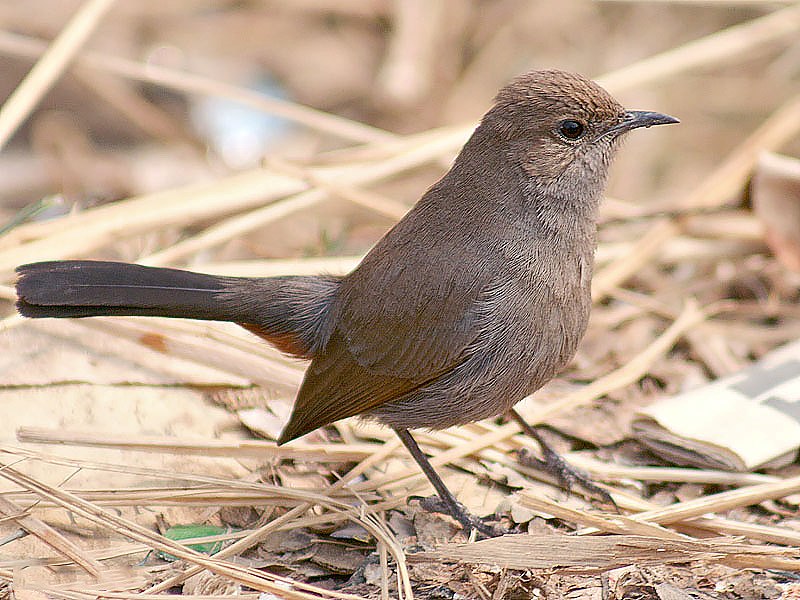
The Sombre Rock Chat is a species of passerine bird found in Ethiopia and Somalia. It prefers dry, shrubby habitats and has been classified as part of the Muscicapidae family.
This small bird typically measures 15-17cm long with a wingspan between 22-25 cm across. Its upperparts are generally greyish brown while its underparts are cream to white with some black barring on the chest area.
The tail feathers are usually tipped in dark colouring, lending it its namesake sombre appearance overall.
Despite their drab colours they can be quite vocal birds and produce melodious chirps throughout the day when active or during mating season which occurs from October through April each year.
They mainly feed on insects but will occasionally take berries if available too providing an important source of nutrition for themScientific classification:
| Kingdom | Animalia |
| Phylum | Chordata |
| Class | Aves |
| Order | Passeriformes |
| Family | Muscicapidae |
| Genus | Oenanthe |
| Species | O. dubia |
30. Abyssinian Roller
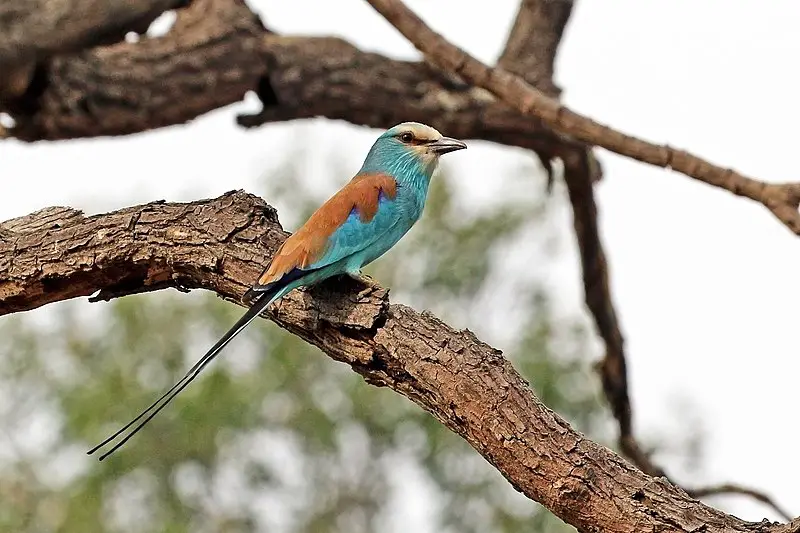
The Abyssinian roller is a large bird, nearly 28 cm in length. It has an unmistakable plumage of bright blue upperparts with chestnut underparts and wings.
Its head is blackish-blue and its tail feathers are white tipped giving it a striking appearance when seen in flight.
This species breeds across tropical Africa from the Sahel belt south of the Sahara desert to East Africa.
Northern populations tend to migrate short distances after wet season while southern ones stay resident throughout year.
They feed mainly on insects which they catch by hovering over fields or open woodland before diving down onto their prey below them.
In addition, they also eat small reptiles, amphibians and rodents along with fruits such as figs occasionally too.Scientific classification:
| Kingdom | Animalia |
| Phylum | Chordata |
| Class | Aves |
| Order | Coraciiformes |
| Family | Coraciidae |
| Genus | Coracias |
| Species | C. abyssinicus |
31. Nechisar Nightjar
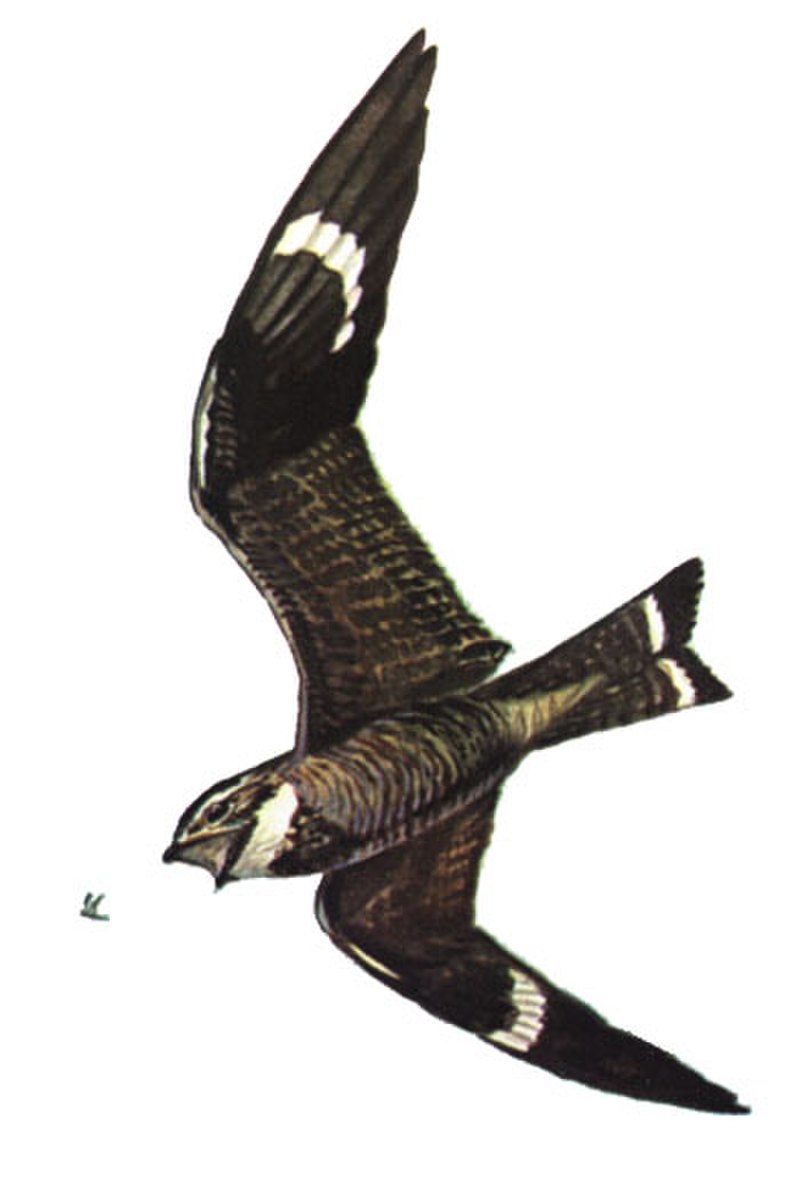
The Nechisar nightjar is a species of bird in the Caprimulgidae family, endemic to Ethiopia. It was discovered in 1990 when researchers found a decomposing specimen at Nechisar National Park.
After bringing back a single wing from it to London’s Natural History Museum, they determined that it was an unknown species.
This nocturnal creature has cryptically-patterned grey and brown plumage which helps camouflage them during their active hours near dusk and dawn.
They feed mainly on insects like moths, beetles and cicadas but sometimes hunt for small amphibians too.
As its habitat faces threats such as loss of natural grasslands combined with climate change, conservation efforts are necessary to ensure the survival of this unique species going forward.Scientific classification:
| Kingdom | Animalia |
| Phylum | Chordata |
| Class | Aves |
| Order | Caprimulgiformes |
| Family | Caprimulgidae |
| Genus | Caprimulgus |
| Species | C. solala |
32. White-Winged Collared Dove
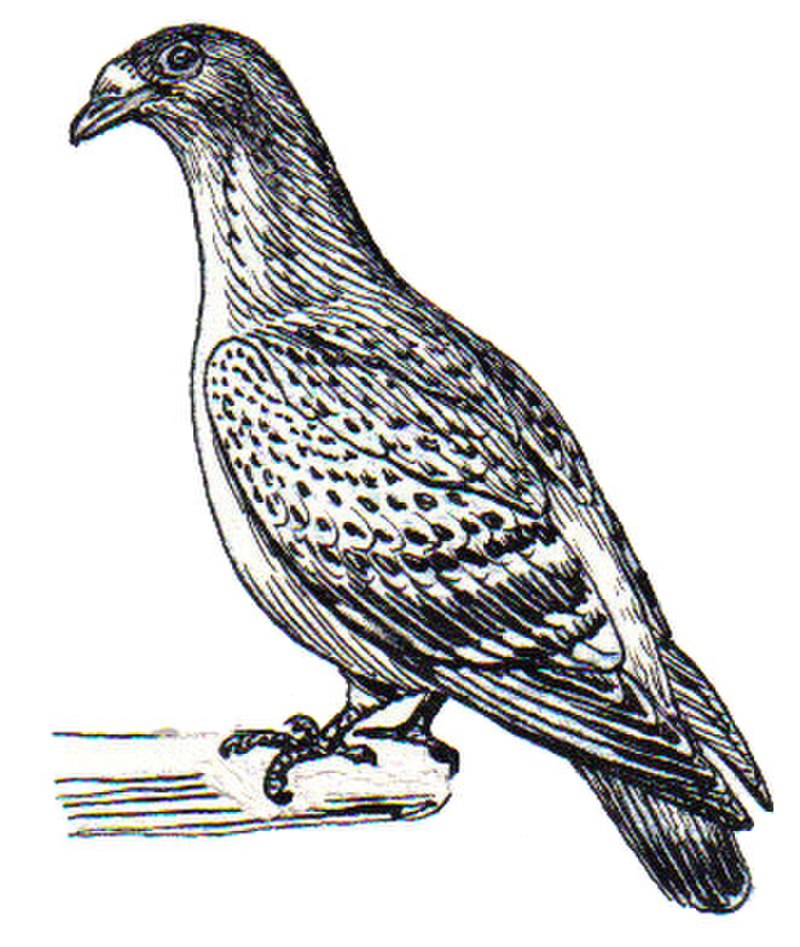
The white-winged collared dove is a species of bird from the family Columbidae found in Ethiopia, Kenya and Somalia. It has beautiful white wings with black stripes that contrast against its brownish gray body giving it an elegant appearance.
The birds usually live in subtropical or tropical moist lowland forests, dry shrublands and plantations but have been seen to inhabit urban areas as well. Unfortunately their habitats are under threat due to human activities such as deforestation which put them at risk of extinction.
Conservation efforts must be taken so these wonderful creatures can continue living peacefully amongst us for many years to come.Scientific classification:
| Kingdom | Animalia |
| Phylum | Chordata |
| Class | Aves |
| Order | Columbiformes |
| Family | Columbidae |
| Genus | Streptopelia |
| Species | S. reichenowi |
33. Somali Starling
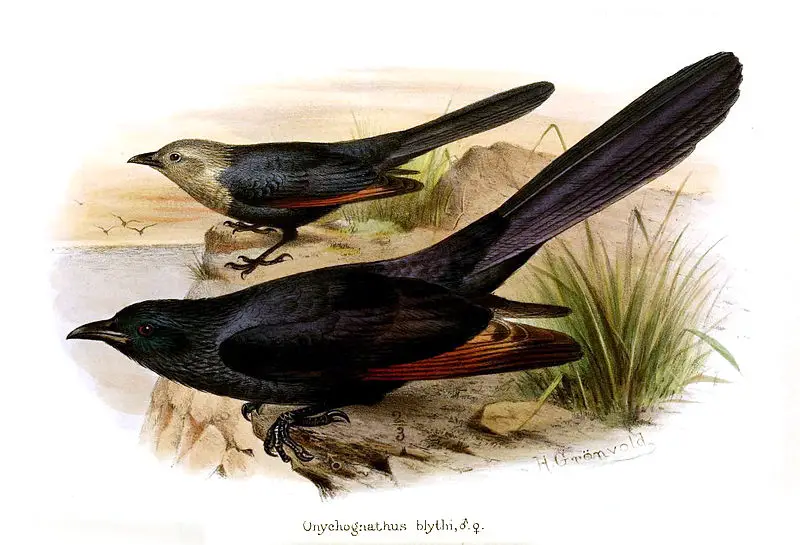
The Somali starling is a beautiful species of bird belonging to the family Sturnidae. It is native to Djibouti, Eritrea, Ethiopia, Somalia and Yemen and can be found inhabiting bushy and shrubby areas in northern Ethiopia’s Degua Tembien district.
These birds are quite small with glossy black feathers on their heads as well as brownish upperparts while they have white underparts which contrast nicely against its darker body. They also feature striking yellow eyes; giving them an almost cartoon-like appearance.
The Somali starling has been classified by the IUCN Red List as Least Concern due to its widespread range across East Africa but it still faces threats from habitat destruction caused by human activities such as farming or logging.Scientific classification:
| Kingdom | Animalia |
| Phylum | Chordata |
| Class | Aves |
| Order | Passeriformes |
| Family | Sturnidae |
| Genus | Onychognathus |
| Species | O. blythii |
Also Featured In: Common Birds of Socotra,
34. Somali Wheatear
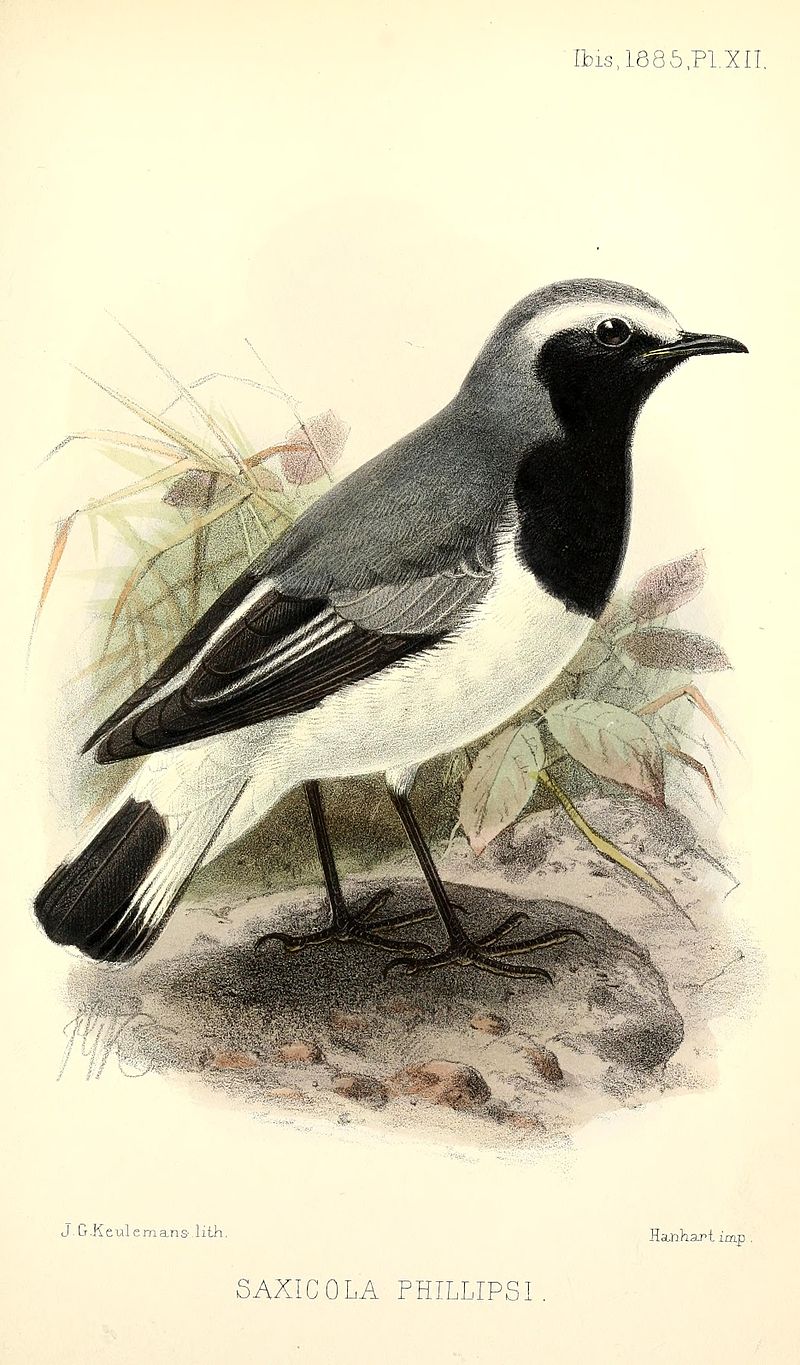
The Somali wheatear is a small bird found in Ethiopia and Somalia. It belongs to the family Muscicapidae, which includes many species of flycatchers. This species has adapted well to its environment with an ability to live in both dry shrublands and lowland grasslands.
They are quite hardy birds that can survive even if food sources become scarce due to their diverse diet consisting mainly of insects but also consuming some fruits or grains as needed.
The plumage of this bird consists mostly of shades of browns, whites and greys making it blend into its surroundings easily when resting or hunting for prey on the ground during the day time hours while they sing at night from high perches above tree branches where they roost until dawn breaks again when they begin their search for sustenance once more before returning back home by dusktime each evening.Scientific classification:
| Kingdom | Animalia |
| Phylum | Chordata |
| Class | Aves |
| Order | Passeriformes |
| Family | Muscicapidae |
| Genus | Oenanthe |
| Species | O. phillipsi |
35. Moorland Francolin
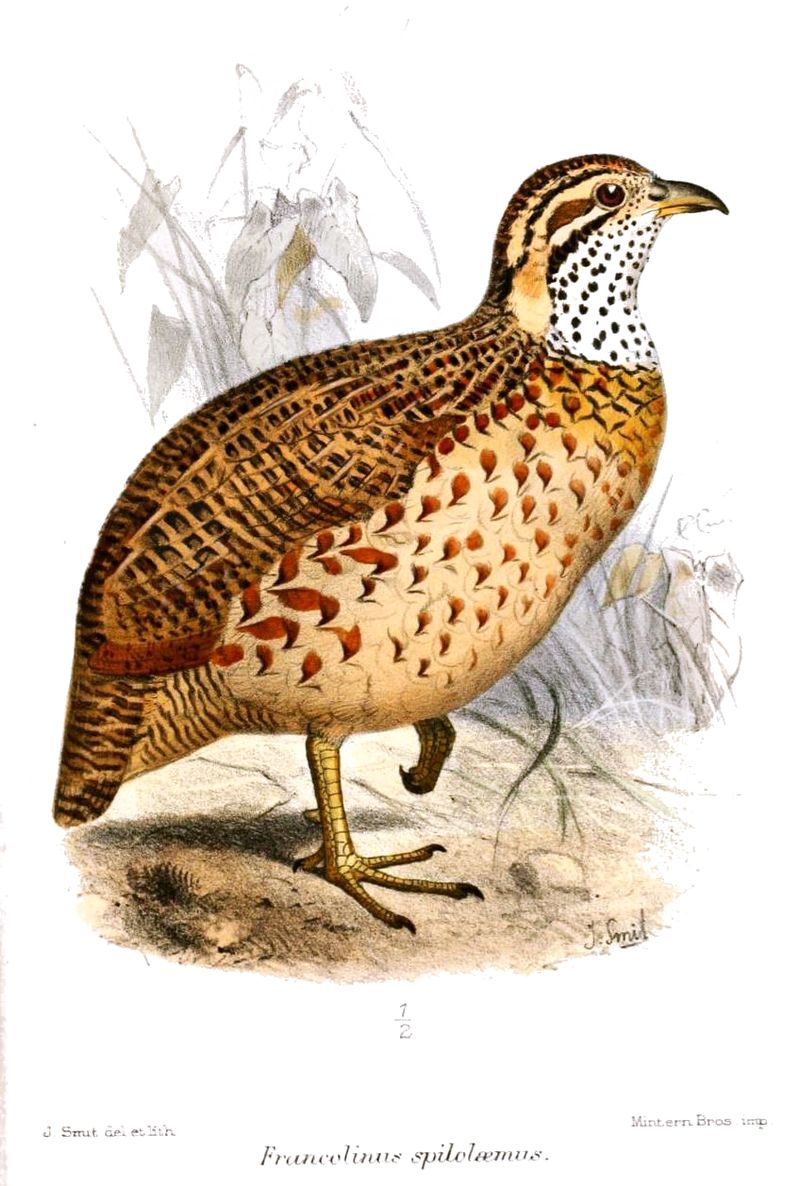
The Moorland Francolin is a species of bird found in the highlands of Ethiopia. It lives primarily on moorland, making it an excellent addition to any aviary.
This unique species has gray upperparts and white underparts with dark barring along its sides. Its face features yellow-orange around its eyes and beak, as well as black streaks across its cheeks.
The IUCN Red List declared this species distinct from Elgon Francolins in 2014 due to differences in their appearance and habitat preferences.
These birds are shy but can make great companions if socialized properly, although they may take some time before they fully trust humans.
With proper care and attention these beautiful birds can live up to 8 years or more.Scientific classification:
| Kingdom | Animalia |
| Phylum | Chordata |
| Class | Aves |
| Order | Galliformes |
| Family | Phasianidae |
| Genus | Scleroptila |
| Species | S. psilolaema |
36. Ankober Serin
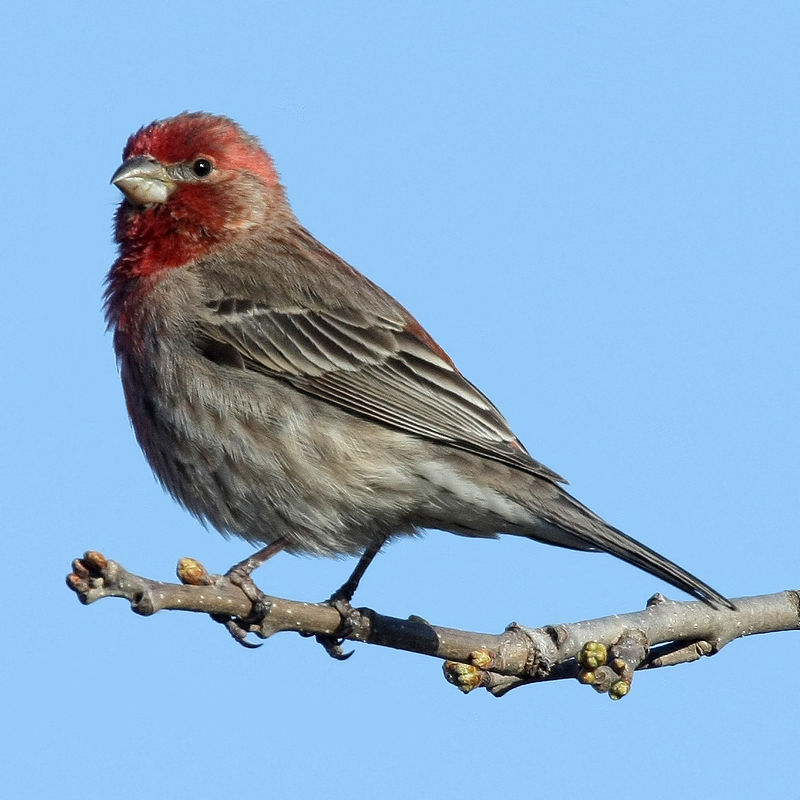
The Ankober Serin is a small finch found only in Ethiopia. It has brown upperparts with buffy-colored streaking on its head and breast, making it easily recognizable amongst other species of birds.
This gregarious bird is often seen in flocks and sings a low twittering song. An adult serin measures around 12 cm (5 inches) long from beak to tail feathers. They feed mainly on seeds but can also eat some insects as well.
These birds live mostly in the highlands of northern Ethiopia where they form large roosts at night for protection against their predators such as hawks or owls.Scientific classification:
| Kingdom | Animalia |
| Phylum | Chordata |
| Class | Aves |
| Order | Passeriformes |
| Family | Fringillidae |
| Subfamily | Carduelinae |
| Genus | Crithagra |
| Species | C. ankoberensis |
37. Mousebird
Mousebirds are small, long-tailed birds native to Afro-Eurasia. They have round bodies and short necks with distinctive crests on their heads. The most prominent feature of mousebirds is the large eyes which give them excellent vision in dim light conditions such as dense forests or thick vegetation.
Mousebirds are omnivores that feed mainly on fruit, seeds, buds and insects but they will also eat other small animals like lizards and snakes when available. Their ability to climb trees makes it easier for them to find food sources at higher levels than ground level species can reach.
A flock of these interesting birds usually consists of four or five members who stay close together while flying and roosting during the day time hours; however they do disperse over night in search of food alone or occasionally in pairs.
The calls made by mousebird vary from a soft chirping sound to loud clicking notes depending upon the situation – whether communicating danger signals among its flock mates or just a friendly call between two individuals.
38. Rüppell’s Weaver
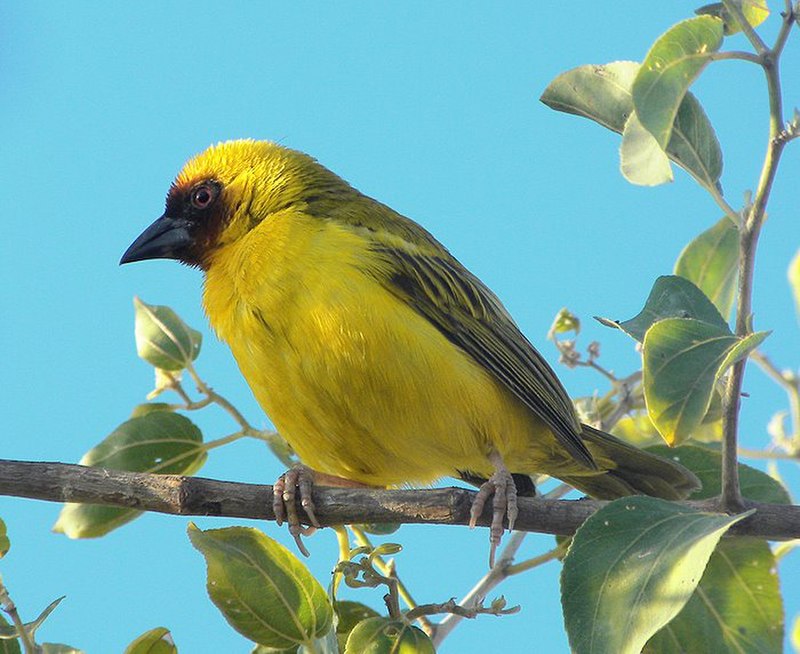
Rüppell’s weaver is a species of bird in the Ploceidae family, native to northern Afrotropics. It was named after German zoologist and explorer Eduard Rüppell.
The range for this species includes Sudan, Somalia and extreme northern Kenya, as well as the south-western Arabian Peninsula.
In Degua Tembien mountains in north Ethiopia it can be seen at high altitudes up to 3200m above sea level.
This small bird has impressive yellowish-green plumage with dark streaks on its chest and back; males may have some orange coloration too.
Their song consists of chirps that get louder towards the end, making them easily recognizable among other members of their family.
As they are highly social birds they often flock together while nesting or feeding on insects such as grasshoppers or beetles near agricultural fields or pastures.Scientific classification:
| Kingdom | Animalia |
| Phylum | Chordata |
| Class | Aves |
| Order | Passeriformes |
| Family | Ploceidae |
| Genus | Ploceus |
| Species | P. galbula |
39. Bare-Faced Go-Away-Bird
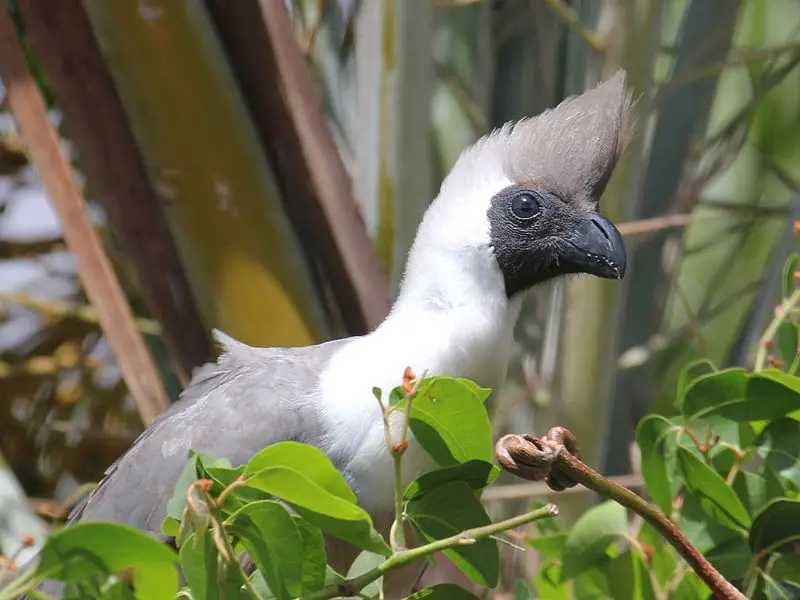
The Bare-faced go-away-bird is an eye catching species of bird native to eastern Afrotropics. It stands out due to its unique bare black face, setting it apart from other birds in the Musophagidae family.
Both sexes are similar except for the female’s green beak and both measure about 19 inches long with a weight of 210 – 300 grams.
These birds make quite a bit of noise as they move around restlessly throughout their habitat, making them easily recognizable by sound alone.
They feed mainly on fruits such as figs and berries which gives them plenty energy for all that movement.
All in all, this species makes an interesting addition to any nature enthusiast’s list of sightings or even just backyard visitors.Scientific classification:
| Kingdom | Animalia |
| Phylum | Chordata |
| Class | Aves |
| Order | Musophagiformes |
| Family | Musophagidae |
| Genus | Crinifer |
| Species | C. personatus |
Also Featured In: Birds that Live in lake Mburo National Park,
40. African Paradise Flycatcher
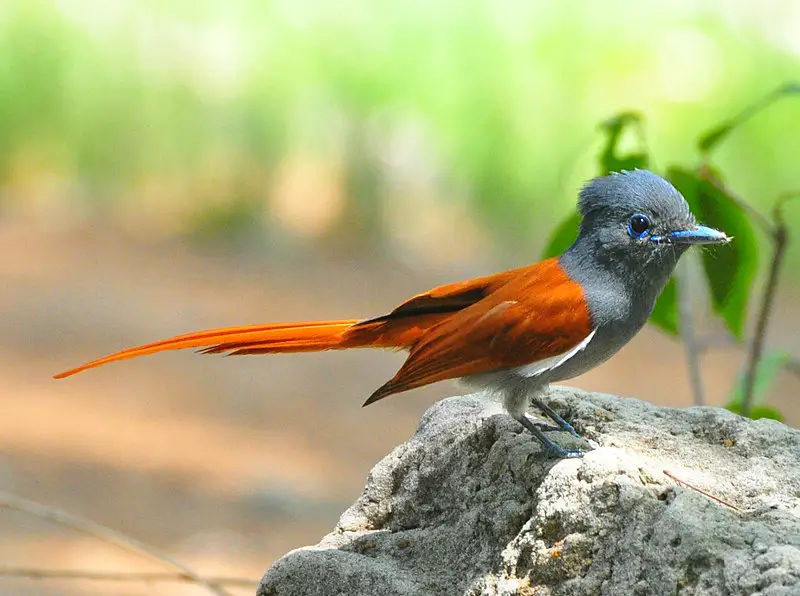
The African paradise flycatcher is a beautiful passerine bird, with the males having tail feathers that extend into streamers twice as long as its body.
Males have chestnut or rusty coloured upper parts on their wings and tails, contrasting nicely against the whitish underparts of both genders.
The head and throat are black for adult males, while females lack this colouration but feature some orange-red streaking instead.
Both sexes bear red eyes and blue-grey legs and feet to round out their appearance.
These birds mainly inhabit tropical forests throughout Sub-Saharan Africa where they feed primarily on insects such as beetles, ants, cicadas; occasionally supplementing it with small fruit when available during certain times of yearScientific classification:
| Kingdom | Animalia |
| Phylum | Chordata |
| Class | Aves |
| Order | Passeriformes |
| Family | Monarchidae |
| Genus | Terpsiphone |
| Species | T. viridis |
Also Featured In: Chad Birds You Didn’t Know, Birds of KwaZulu-Natal
41. Erlanger’s Lark
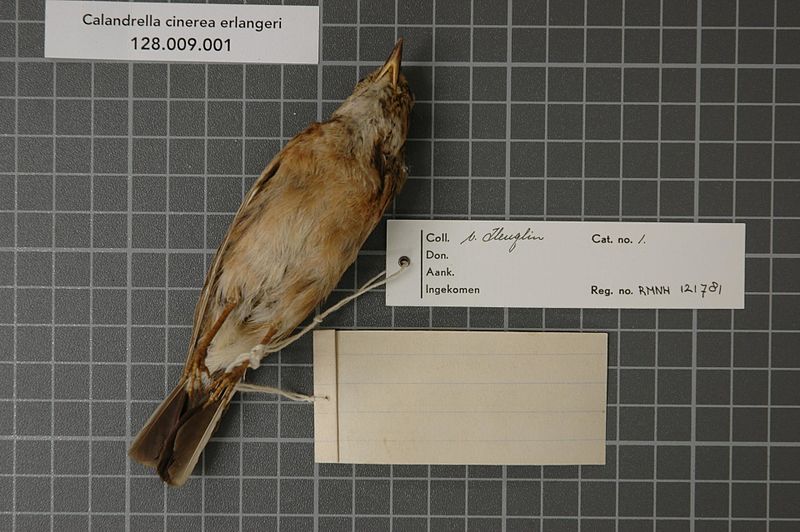
Erlanger’s lark is a species of bird endemic to the highlands of Ethiopia. It is part of the lark family, and has been named after German ornithologist Carlo von Erlanger.
This small passerine bird has an alternate name – Erlanger’s red-capped lark, or Ethiopian short-toed lark – and it is considered to be closely related to Blanford’s Larks.
These birds are usually found living in open areas with low vegetation such as grassland plains or semi-desert scrublands at altitudes ranging from 3200–4500m above sea level.
They feed on insects, seeds and grain crops like barley which they find while foraging along bare ground during their nonbreeding season. They also use these food sources when breeding too.
The population size of this species appears stable overall but its range seems quite limited so conservation measures should continue in order to prevent any potential decline in numbers that could arise due habitat loss caused by agricultural development within its range area.Scientific classification:
| Kingdom | Animalia |
| Phylum | Chordata |
| Class | Aves |
| Order | Passeriformes |
| Family | Alaudidae |
| Genus | Calandrella |
| Species | C. blanfordi |
| Subspecies | C. b. erlangeri |
42. Hartlaub’s Babbler
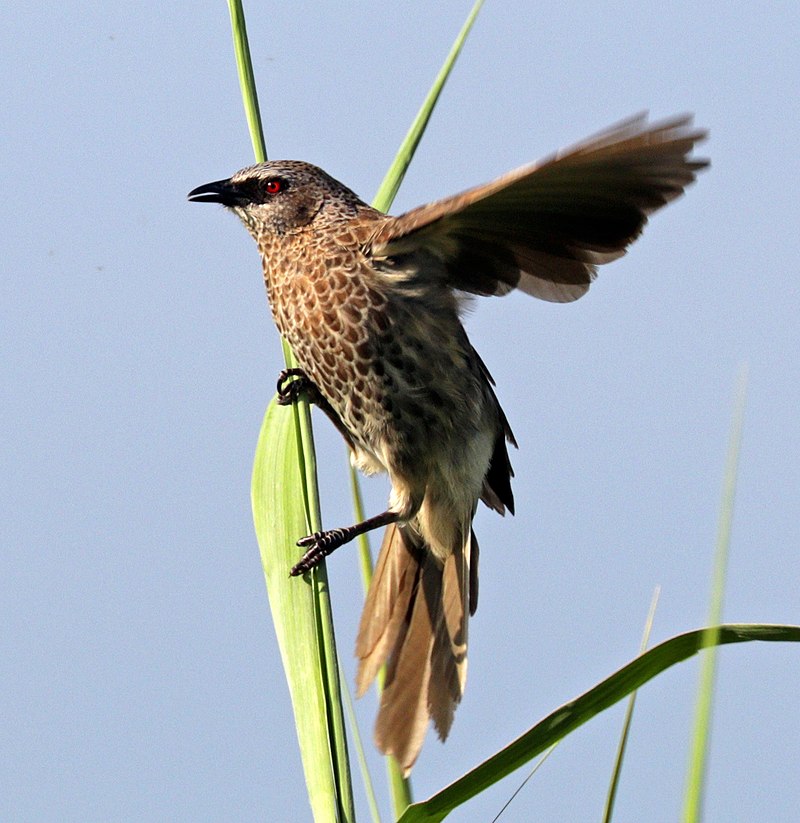
Hartlaub’s babbler, also known as the Angola babbler, is a species of bird in the family Leiothrichidae that can be found in south central Africa. It has been named after German physician and ornithologist Gustav Hartlaub.
This bird inhabits countries such as Angola, Botswana, Burundi, DRC (Democratic Republic of Congo), Namibia Rwanda Tanzania Zambia and Zimbabwe. The habitat for this species tends to be open woodland or scrub where it feeds on insects and other invertebrates by scratching around with its feet on the ground like chickens do.
They usually hunt their prey in pairs or groups making short vocalizations while doing so which makes them easily recognizable among other birds living nearby.Scientific classification:
| Kingdom | Animalia |
| Phylum | Chordata |
| Class | Aves |
| Order | Passeriformes |
| Family | Leiothrichidae |
| Genus | Turdoides |
| Species | T. hartlaubii |
43. Woodland Kingfisher
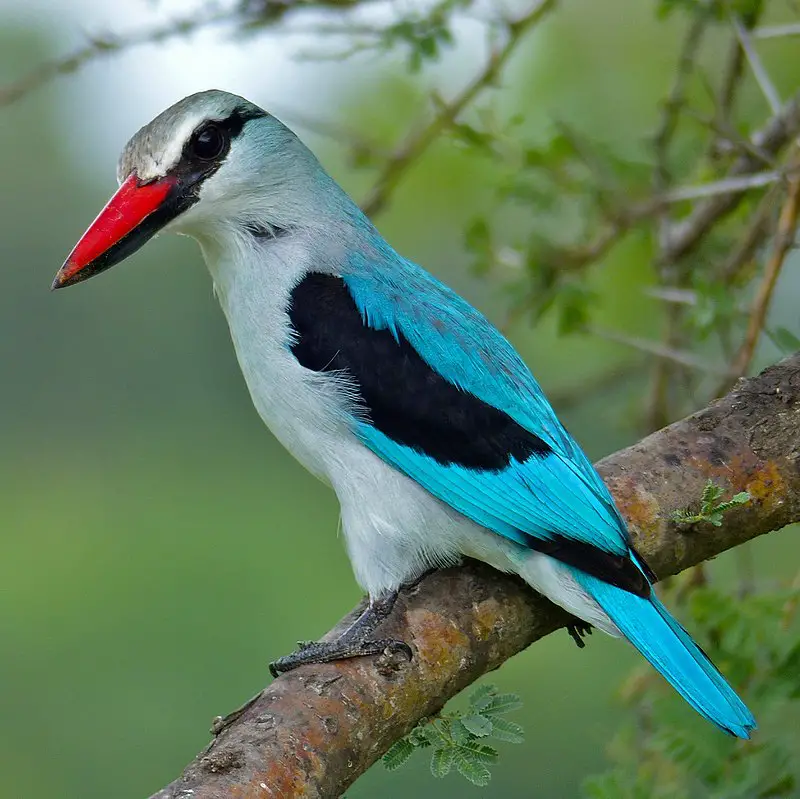
The Woodland Kingfisher is a beautiful bird, native to Africa south of the Sahara. It was first described in 1766 by Carl Linnaeus who called it Alcedo senegalensis.
This tree kingfisher has an attractive blue and white plumage with some red and black markings on its wings, tail and head.
The male also has a bright orange beak which helps to distinguish him from the female whose beak is yellowish-green.
These birds can usually be found in wooded areas near water sources such as rivers or lakes where they hunt for food including fish, frogs, small insects and even lizards.
They build their nests either high up in trees or inside holes dug out of banks near rivers and ponds.
Although not threatened yet, these lovely creatures need our protection so that future generations will have the chance to marvel at them too.Scientific classification:
| Kingdom | Animalia |
| Phylum | Chordata |
| Class | Aves |
| Order | Coraciiformes |
| Family | Alcedinidae |
| Subfamily | Halcyoninae |
| Genus | Halcyon |
| Species | H. senegalensis |
44. Red-Fronted Tinkerbird
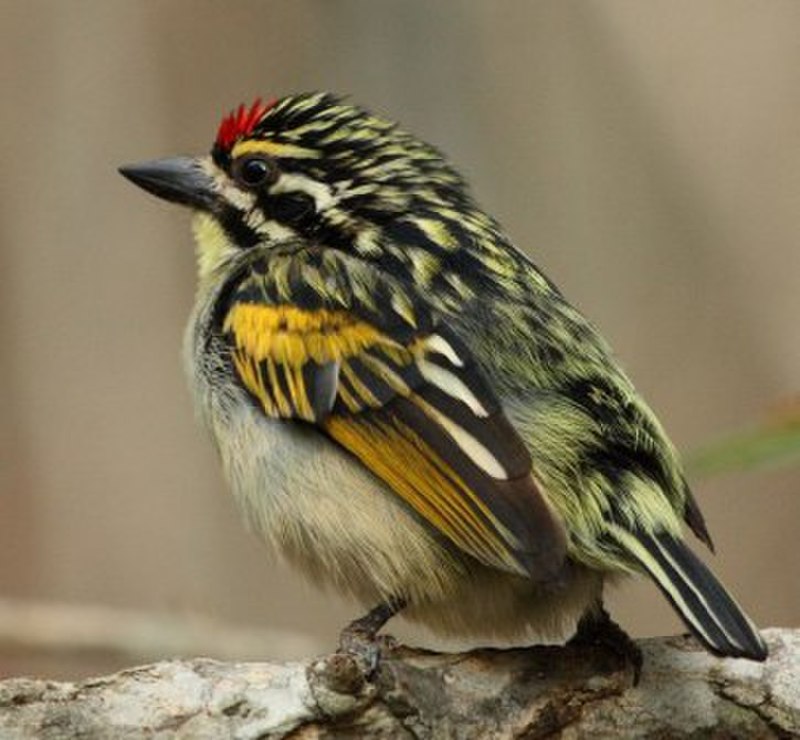
The Red-fronted Tinkerbird is a small African barbet species that can be found in many tropical regions around the world. It is most commonly seen in eastern South Africa, with an additional population extending from Sudan and Ethiopia to Tanzania.
This bird has a distinctive red forehead, as well as black wings and plumage on its back. Its bill also features bristles at the base which are used for grooming purposes.
The diet of this bird consists mainly of fruits, seeds and insects which it will search for among tree branches or bushes using its long tongue.
They prefer to live in pairs but often form larger flocks during breeding season when they engage in complex courtship rituals involving singing duets between males and females.
Overall, these birds bring colour and life into their environment with their vibrant colours making them quite attractive creatures indeed.Scientific classification:
| Kingdom | Animalia |
| Phylum | Chordata |
| Class | Aves |
| Order | Piciformes |
| Family | Lybiidae |
| Genus | Pogoniulus |
| Species | P. pusillus |
45. Dusky Turtle Dove
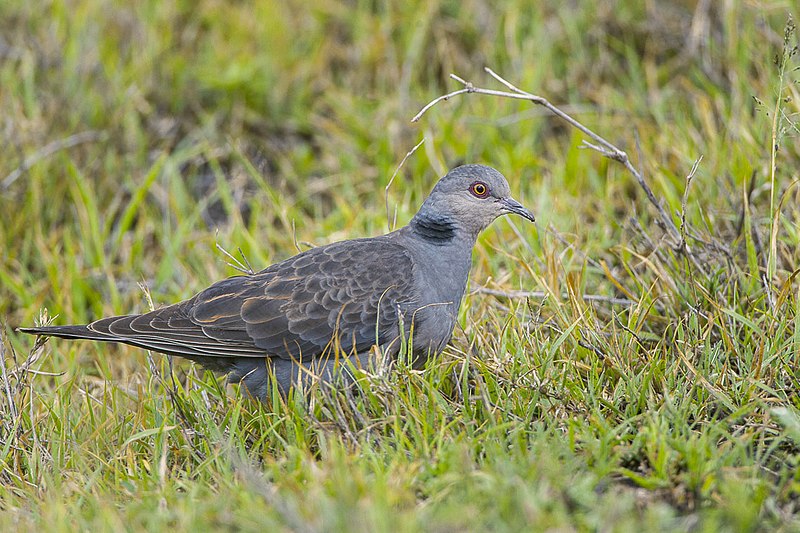
The dusky turtle dove is a species of bird found in many African countries, as well as Saudi Arabia and Yemen. It belongs to the family Columbidae and has a distinctively dark plumage with white spots on its wings.
Its long tail gives it an elegant appearance when flying. In addition to this, they have calls that are described as low-pitched whistles or mellow purring sounds which can be heard early in the morning or late at night.
They live singly or in pairs near open woodlands where there are plenty of tall trees for them to roost on during the day time. Dusky Turtle doves feed mainly on grains but may also eat small insects if available.
Despite their declining population due to habitat loss, these birds still remain an important part of Africa’s avian diversity and need our help for conservation.Scientific classification:
| Kingdom | Animalia |
| Phylum | Chordata |
| Class | Aves |
| Order | Columbiformes |
| Family | Columbidae |
| Genus | Streptopelia |
| Species | S. lugens |
46. Black-Billed Barbet
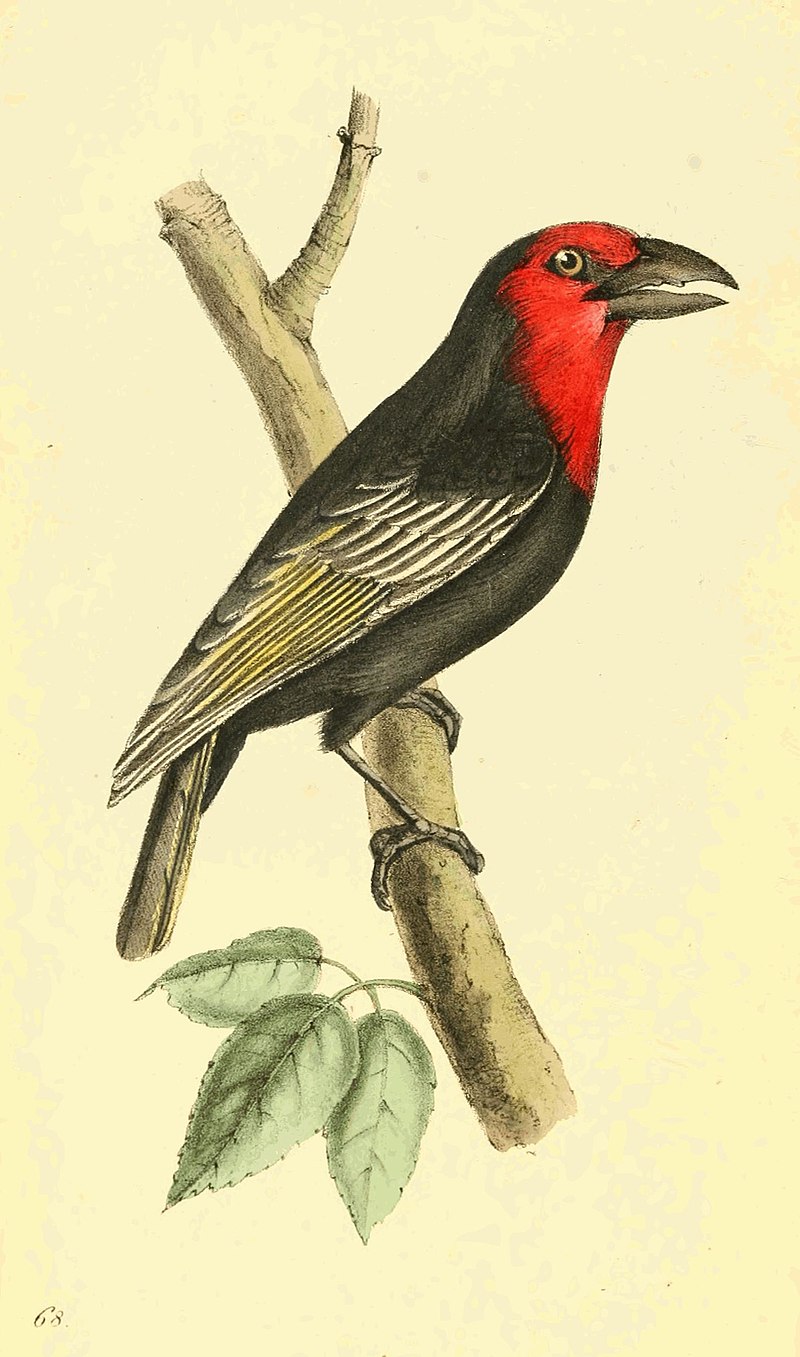
The Black-billed Barbet is a species of bird belonging to the Lybiidae family. It has an extremely large range in the Afrotropical realm, spanning from Cameroon and northeastern Democratic Republic of Congo all the way up to Eritrea, Sudan, Ethiopia, Kenya, Tanzania and Uganda.
This impressive bird prefers altitudes between 900 – 2200 metres above sea level. Its plumage consists mainly of brownish grey feathers with black bills which give it its name. The barbet also has yellow eyes with white eyerings that stand out against its otherwise dark face.
These birds are insectivores by nature and feed on insects found near their preferred habitats such as shrubs or trees in forests or woodlands instead of open grassland areas.Scientific classification:
| Kingdom | Animalia |
| Phylum | Chordata |
| Class | Aves |
| Order | Piciformes |
| Family | Lybiidae |
| Genus | Lybius |
| Species | L. guifsobalito |
47. Augur Buzzard
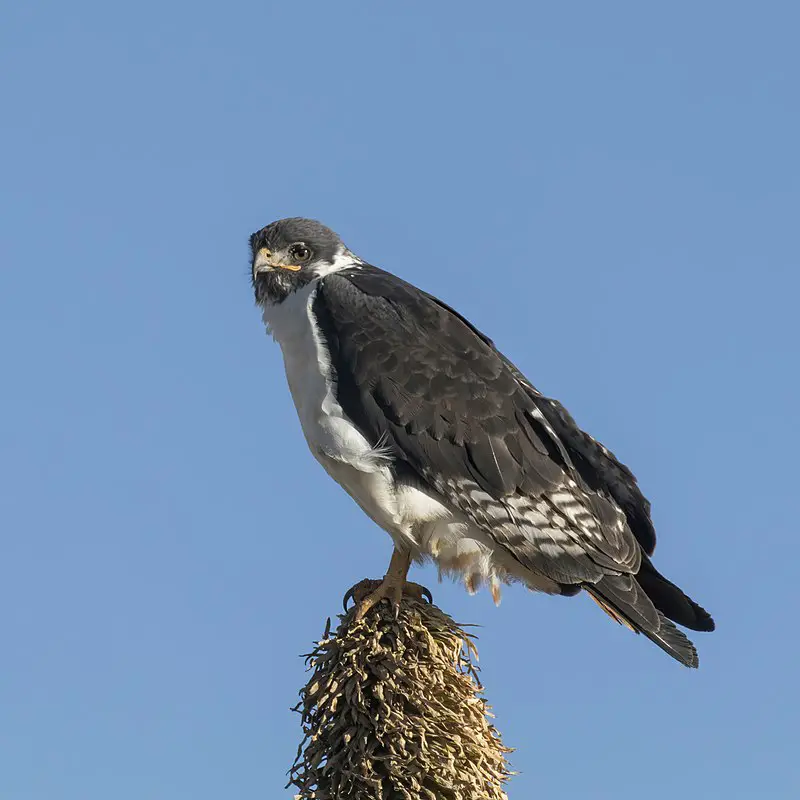
The Augur Buzzard is an impressive African bird of prey, typically identified by its blackish back and wings, white underside and orange-red tail. A dark morph also exists for this species while juveniles are usually brown in colour.
It is found throughout Central and Southern Africa where it inhabits a variety of habitats ranging from grasslands to wooded savannas.
This Buteo genus member has a wide range of food sources including rodents, reptiles, insects and other birds making it quite versatile when hunting for sustenance.
Its powerful talons allow the buzzard to snatch up large prey with ease ensuring that meals are never far away.Scientific classification:
| Kingdom | Animalia |
| Phylum | Chordata |
| Class | Aves |
| Order | Accipitriformes |
| Family | Accipitridae |
| Genus | Buteo |
| Species | B. augur |
Also Featured In: East African Birds, Birds that Ngorongoro Crater
48. Little Brown Bustard
The Little brown bustard is a species of bird found in Ethiopia and Somalia. It is the smallest of its kind, measuring 45cm long and weighing 600 grams.
Its natural habitats are dry shrubland and lowland grasslands, however it faces threats from habitat destruction due to human activity. This small bustard typically has dark brown feathers on top with pale underparts.
The wings have white bars which can be seen when they are in flight as well as during their courtship displays where males will display their whitish tail coverts while calling out loudly to attract females.
The little brown bustard is an important part of these ecosystems, playing vital roles like seed dispersal and providing food for other animals such as vultures or raptors that feed off them once they die naturally or after being hunted by humans illegally.Scientific classification:
| Kingdom | Animalia |
| Phylum | Chordata |
| Class | Aves |
| Order | Otidiformes |
| Family | Otididae |
| Genus | Eupodotis |
| Species | E. humilis |
49. White-Winged Flufftail
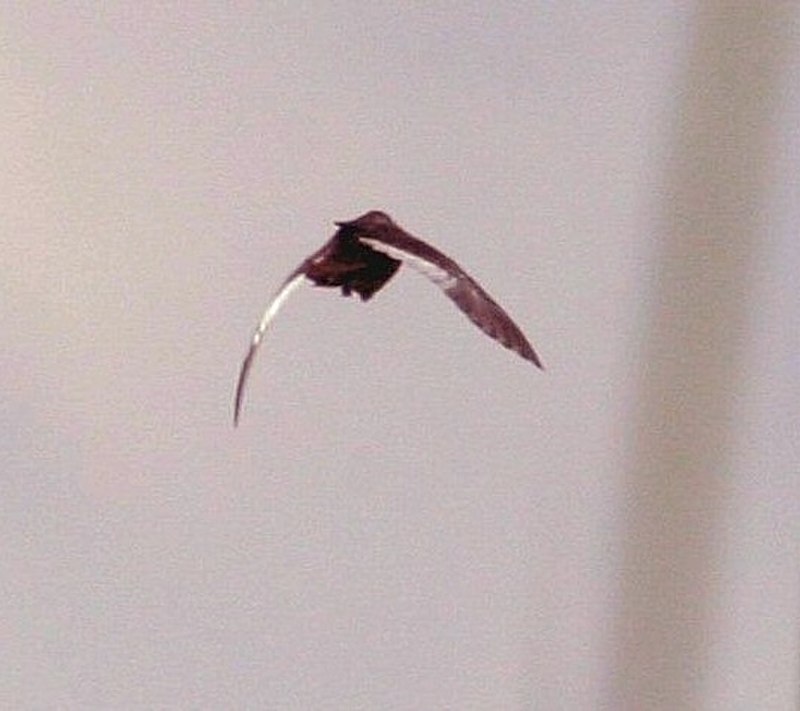
The white-winged flufftail is an incredibly rare bird found in Ethiopia and South Africa. It belongs to the family Sarothruridae with a population size of less than 250 adults worldwide, making it one of the most endangered species on Earth.
Both sexes have dull plumage, dark crowns and when flying they show white wings which are used as their namesake.
They live mainly near wetlands or moist grasslands where they feed upon insects such as moths, beetles and caterpillars by foraging through vegetation.
Unfortunately due to habitat loss from human activities like urbanization, agricultural expansion and wetland drainage these birds may soon become extinct unless conservation action is taken quickly.Scientific classification:
| Kingdom | Animalia |
| Phylum | Chordata |
| Class | Aves |
| Order | Gruiformes |
| Family | Sarothruridae |
| Genus | Sarothrura |
| Species | S. ayresi |
50. Spur-Winged Lapwing

The Spur-winged Lapwing is a species of wader found in the family Charadriidae.
It breeds around the eastern Mediterranean and Africa, where it inhabits savannahs, wetlands and grasslands.
Its plumage is mainly black with white wing stripes and yellow legs.
This bird has an impressive crest on its head that gives it a distinctive look amongst other lapwings.
The most interesting feature of this bird though is the spurs on its wings which are believed to be part of an unattested cleaning symbiosis between them and Nile crocodiles.
It feeds mostly on insects, larvae, worms as well as some plant material such as seeds or fruits.
Overall these birds can live up to 15 years in their natural habitat making them one of longest lived among all wading species.Scientific classification:
| Kingdom | Animalia |
| Phylum | Chordata |
| Class | Aves |
| Order | Charadriiformes |
| Family | Charadriidae |
| Genus | Vanellus |
| Species | V. spinosus |
Also Featured In: Flight Birds You Should Know, Birds You’ll Find in Zoo